Once upon a time, Khiva was tainted with a dreadful past fraught with the atrocity of the slave trade, barbaric savagery, menacing journeys through uncharted deserts, and marauding Turkmen tribesmen. Even the most daring of the brave hearts used to have second thoughts before embarking on an adventure in and around Khiva.
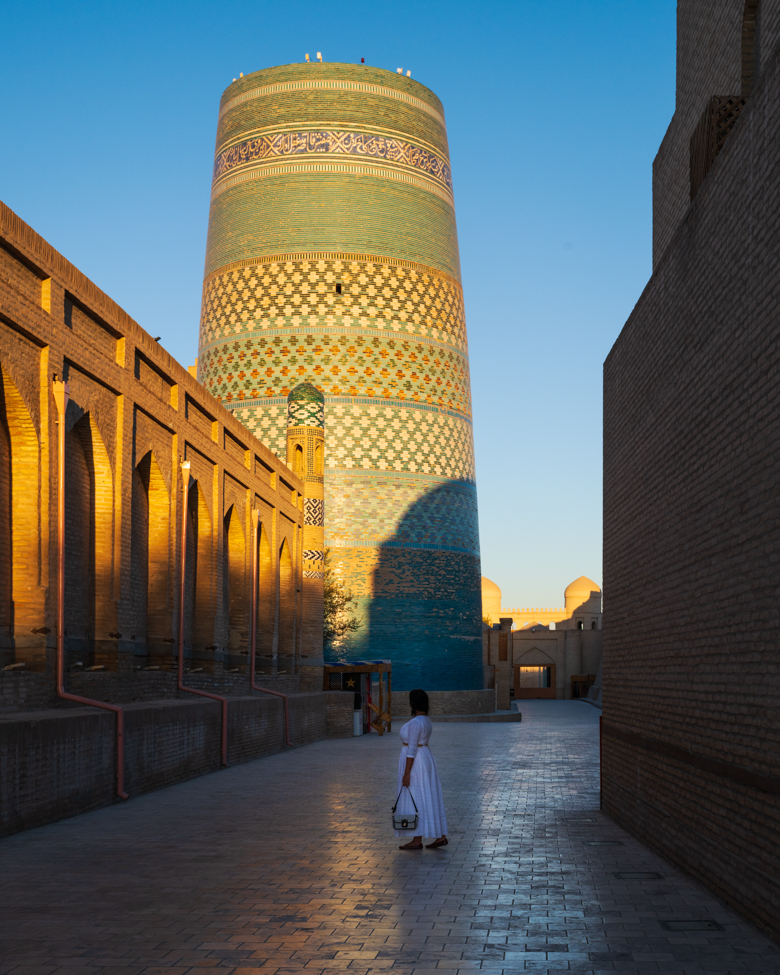
Fortunately, Khiva has left this terrible past behind and evolved into one of the most popular tourist destinations in Uzbekistan. In 1990, Khiva’s old town called Itchan Qala was listed as a UNESCO World Heritage Site (the first in Uzbekistan). In 2024, Khiva was named the Tourism Capital of the Islamic World. In short, Khiva’s historical monuments and cultural heritage (sans the dark episode of slave caravans) have fascinated travellers and scholars alike.
The Itchan Qala is the heart of Khiva. The muddy walls encircle the monotoned monuments laced with turquoise tiles. You will run into a forgotten madrassa or a tilted minaret at every bend of the cobbled paths. There is no dearth of medieval monuments here, and each is preserved to perfection. Dotted with countless ruins, the walled city thus resembles an open museum. As you wander along the meandering alleys of Khiva at sunset or night, the moonlit silhouettes of the madrassas and minarets spell magic.
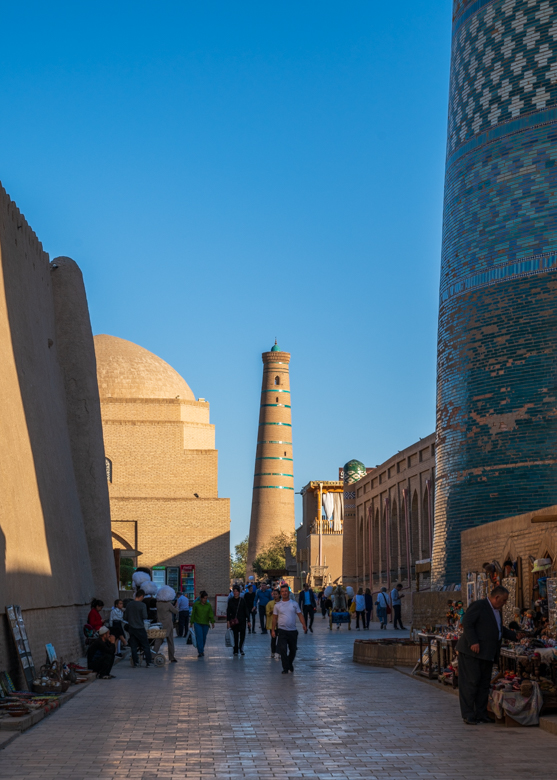
Table of Contents
History of Khiva:
According to the legend, Khiva was founded by Noah’s son, Shem. He discovered a well here, which his followers named ‘Kheivak’. The name of Khiva is believed to be derived from this.
Khiva is part of the Khorezm region, an oasis on the Amu Darya (Oxus) river delta. Khorezm is one of the oldest historical and cultural regions of Central Asia. Human habitation in Khorezm dates back to the Neolithic Age when it was the cradle of the Kelteminar Culture of hunters and fishermen.
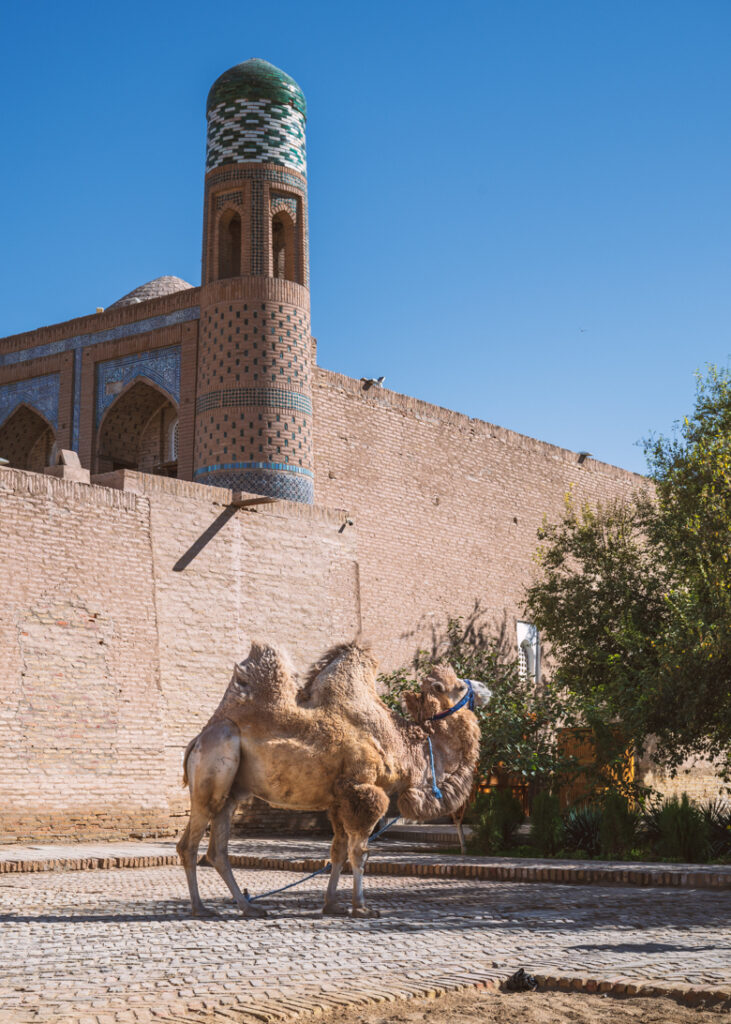
In the Early Iron Age, Khorezm attained its first statehood in the 7th-6th century BCE. During this period, Khorezm had trade relations with India, China, Egypt, and Mesopotamia. Shortly afterwards, Khorezm was ruled for the next 200 years by the Achaemenids. Finally, Khorezm attained independence when Khorezm Shah Farasman agreed to march east with Alexander the Great.
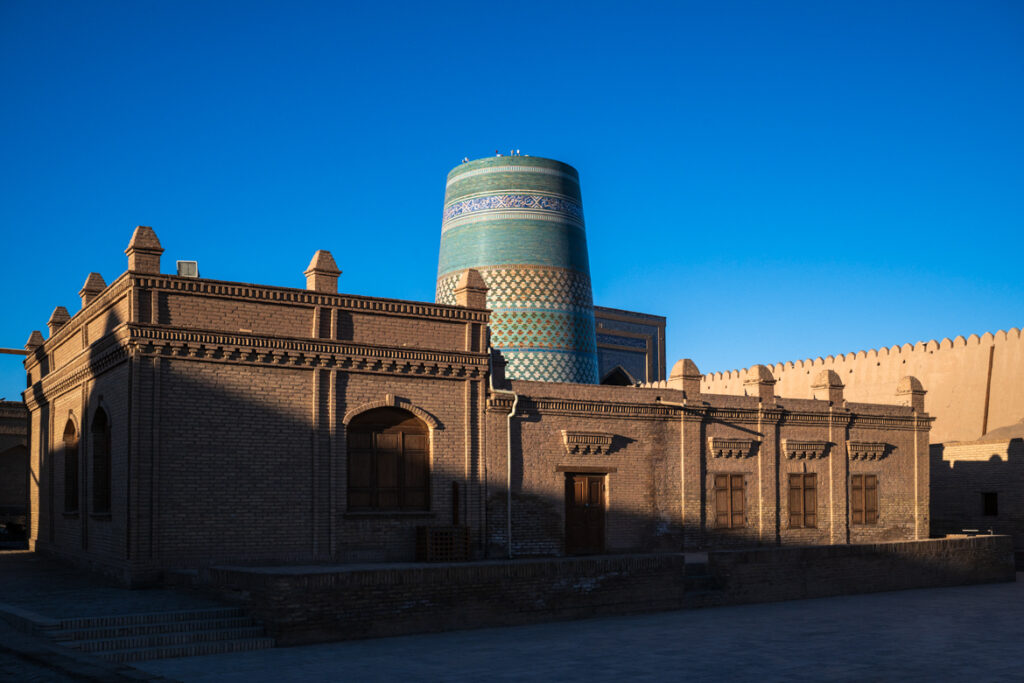
In the 8th and 9th centuries CE, Khiva existed as a minor trade outpost. However, during this era, Khiva witnessed the rise of two men of letters—Muhammad Ibn Musa al-Khwarizmi, a scientist, mathematician, geographer, astronomer, historian, and inventor of ‘algebra’, and Muhammad Ibn Ahmad al-Beruni, an expert in mathematics, physics, and astronomy and renowned as a historian, linguist, chronologist, and Indologist.
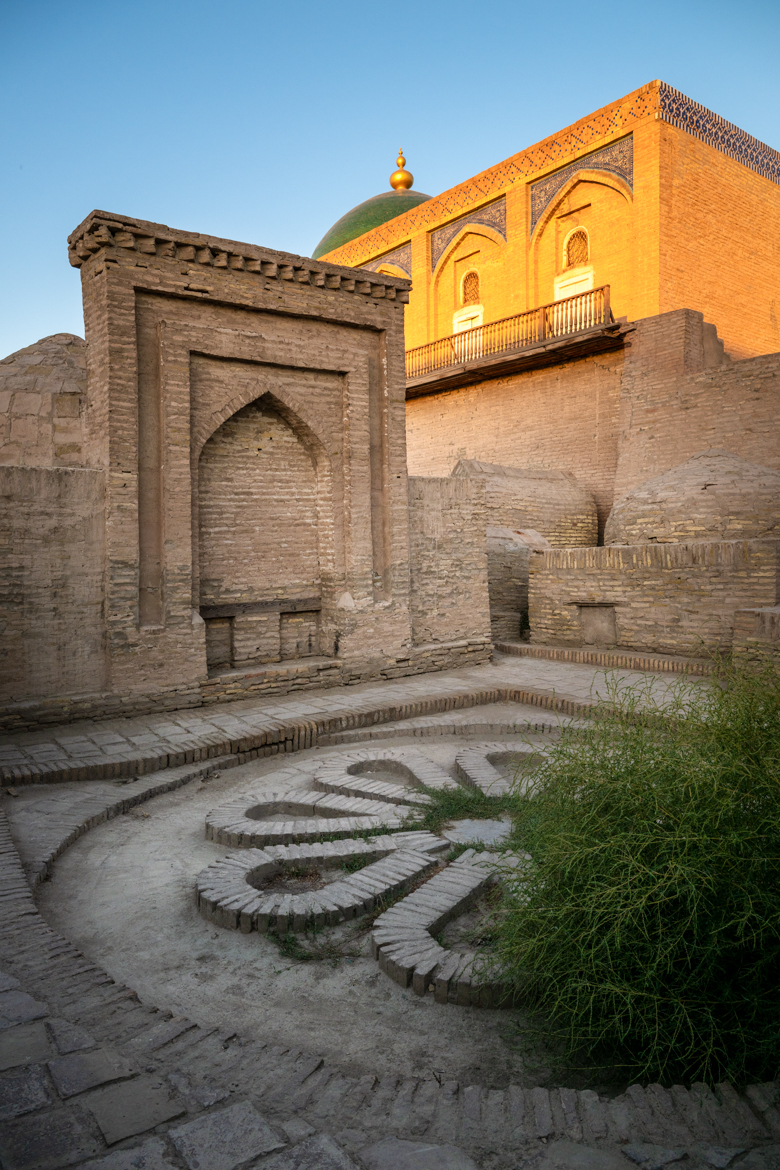
Throughout, Khiva continued as a minor player until the early 16th century when a branch of the Shaybanid dynasty founded a Khorezm state and made Khiva their capital in 1592 CE.
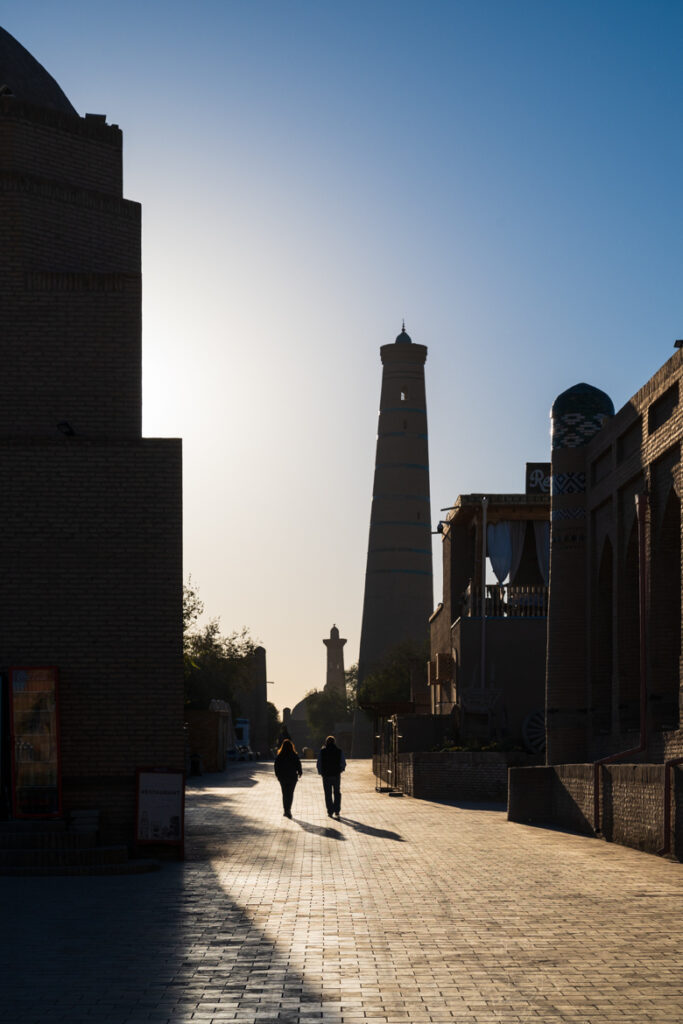
For the next three centuries, Khiva underwent a harrowing episode of the slave trade. Khiva’s notorious slave market was regarded as the largest in Central Asia and proved to be lucrative for the Khanate. The slave trade was so profitable that it even grappled with Nadir Shah’s raid in 1740 CE and continued unabated.
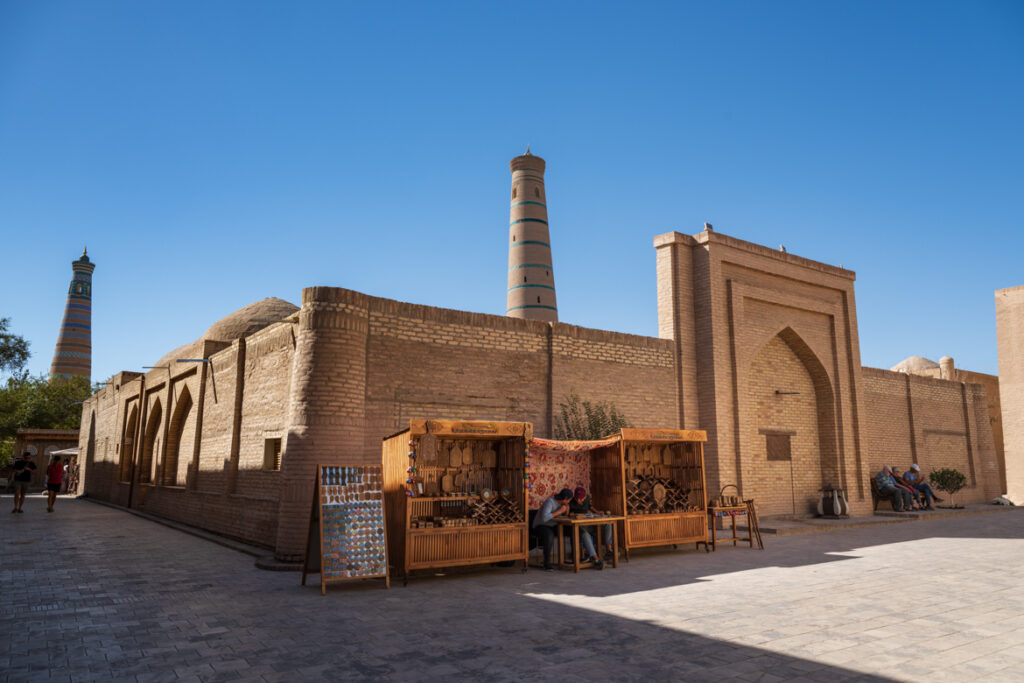
Eventually, Khiva was conquered by Russia in 1873 CE and the Khan became a vassal of the Tsar. In time, Khiva became a part of the new Uzbek SSR in 1924 CE.
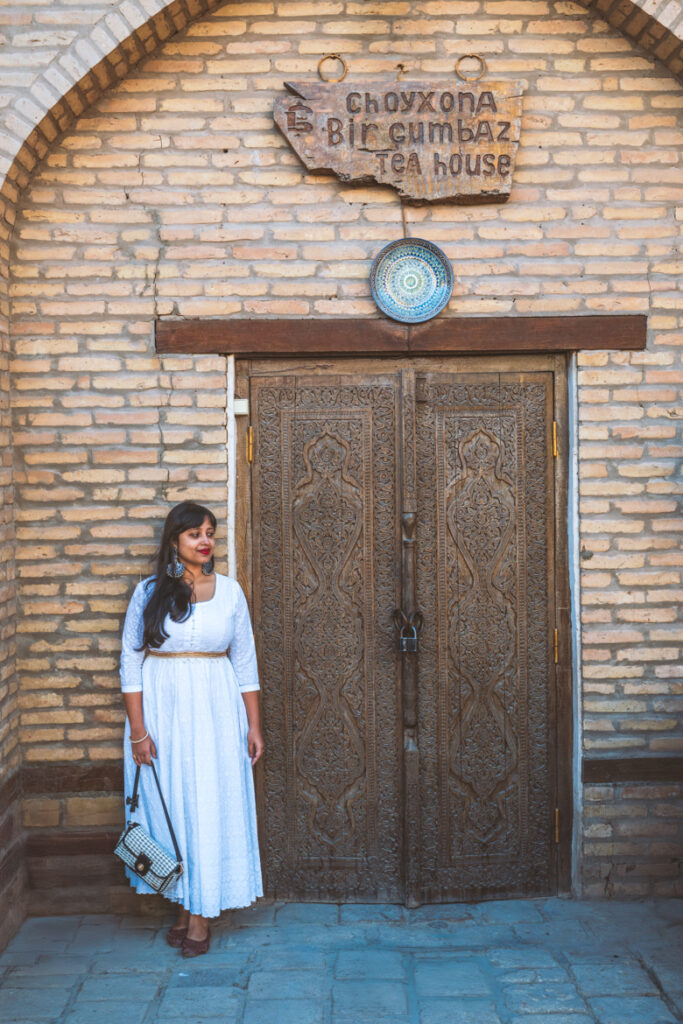
What to see in Khiva:
Itchan Qala:
The Itchan Qala, the fortified old town, is the heart of Khiva’s thriving tourism. This medieval walled town is a repository of dozens of perfectly preserved mosques, madrassas, and mausoleas. Its winding alleys whisper the tales of the bygone era. Wandering on the cobbled paths of the Itchan Qala at dawn or dusk surely turns the clock back.
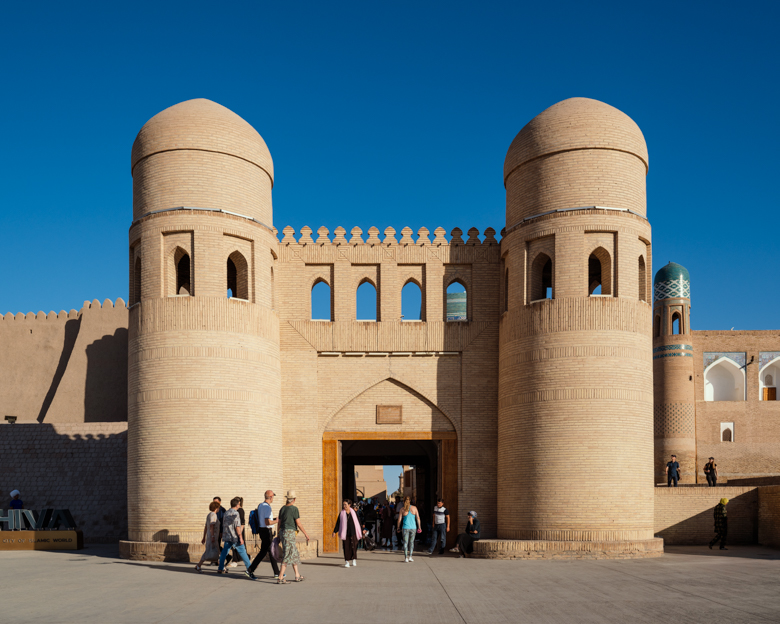
The Itchan Qala has 4 gates – North or Bogcha Darvoza (Garden Gate), East or Pahlavon Darvoza (Strongman’s Gate), South or Tosh Darvoza (Stone Gate), and West or Ota Darvoza (Father Gate). The West Gate is the main entrance to the Itchan Qala.
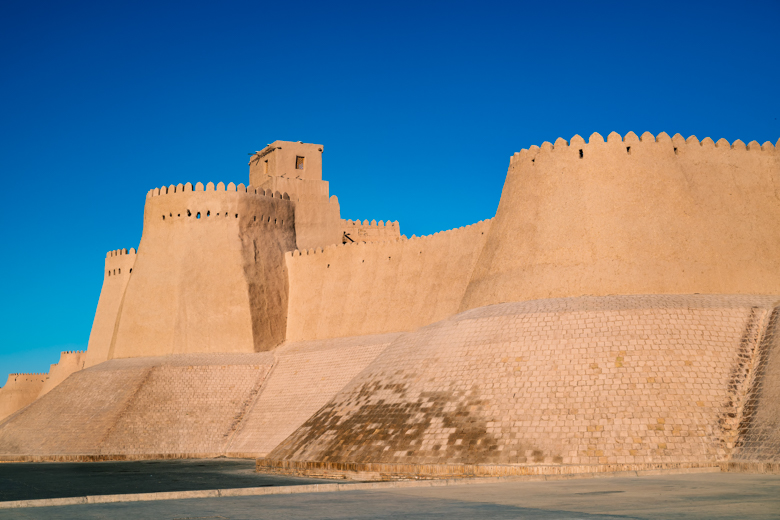
- Timings: Every day from 8 AM to 8 PM. However, if you are staying inside the confines of the Itchan Qala, you can roam freely in the old town.
- Tickets: The entry fee is UZS 200,000, and the ticket is valid for two consecutive days. It can only be bought from the twin-turreted West Gate. However, you don’t require an entrance ticket if your accommodation is inside the Itchan Qala.
- Time required: A minimum of two days as Khiva’s top attractions are within the walls of the Itchan Qala.
- Pro tip:
- The Itchan Qala ticket provides access only to a few smaller monuments. You need to buy separate tickets for the major spots.
- Previously, no ticket was needed to walk along the city walls lying to the northwest of the Itchan Qala. Now, an entry fee of UZS 100,000 has been levied.
- The best time to wander the alleys of the Itchan Qala is at dawn (when the exasperating tourists are yet to flood the old town in large groups led by equally vexing guides) and at night (when the hordes of tourists have left for good).
- The Itchan Qala is a confined zone and thus gets easily crammed with countless visitors. Moreover, the alleys are lined with souvenir shops, which makes walking bothersome.
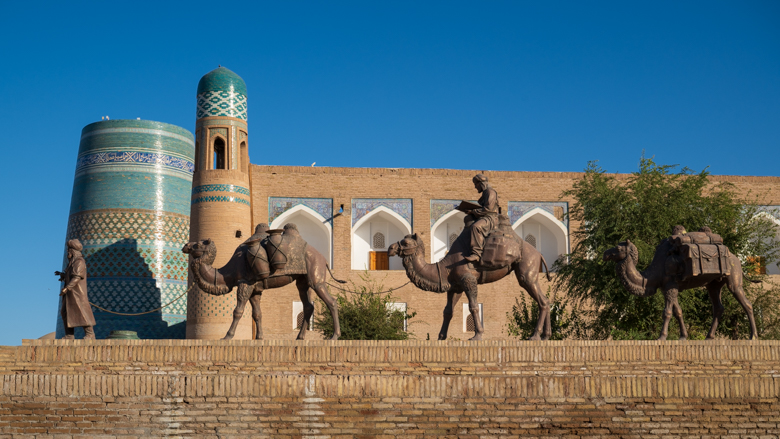
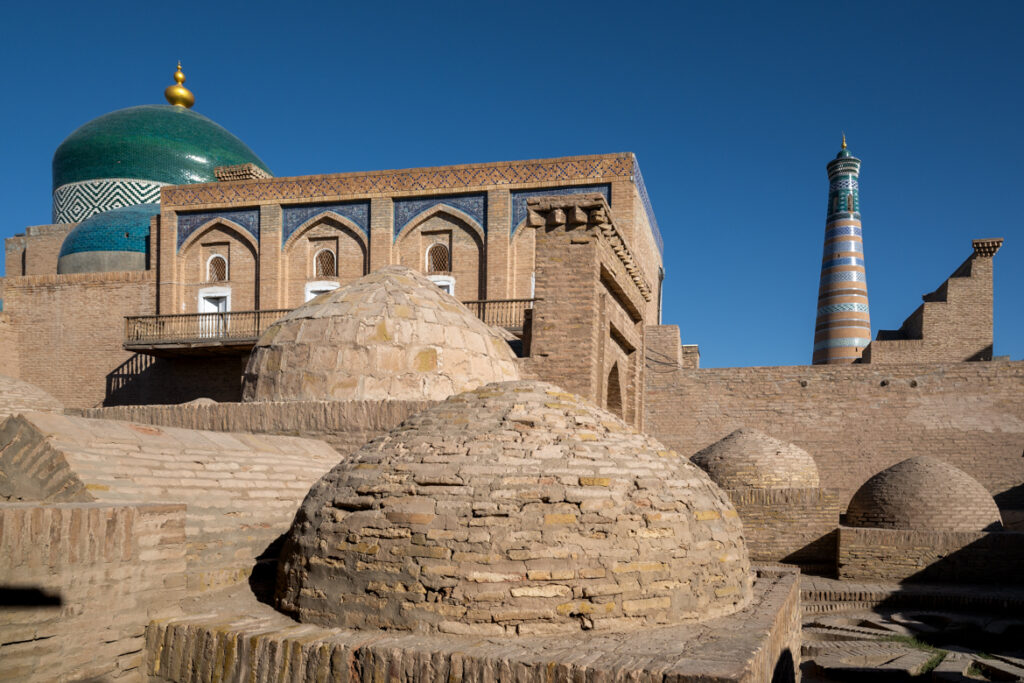
Kalta Minor:
The turquoise-tiled minaret is the cynosure of Khiva. The construction began in 1851 CE under the patronage of Mohammad Amin Khan. The original plan was to build the tallest minaret in the region so that the Khan could see all the way to Bukhara. Unfortunately, the Khan passed away in 1855 CE. With his death, the construction of the Kalta Minor came to a halt.
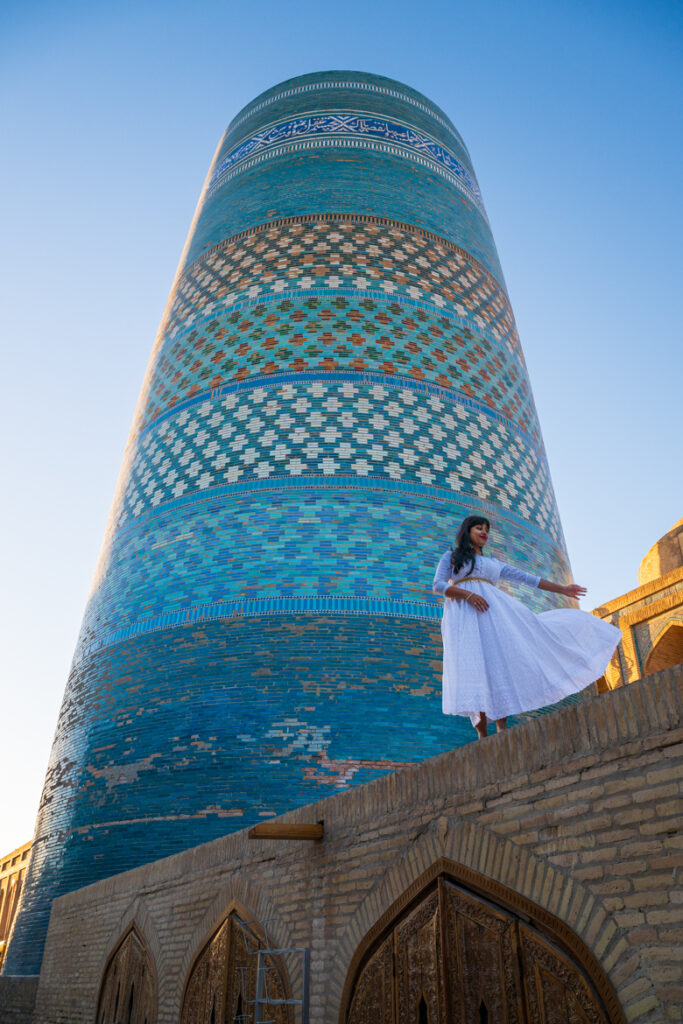
The Kalta Minor is located just beside the West Gate, and visible from anywhere within the Itchan Qala. Standing tall in its half-finished glory, this minaret is one of the architectural gems of Uzbekistan.
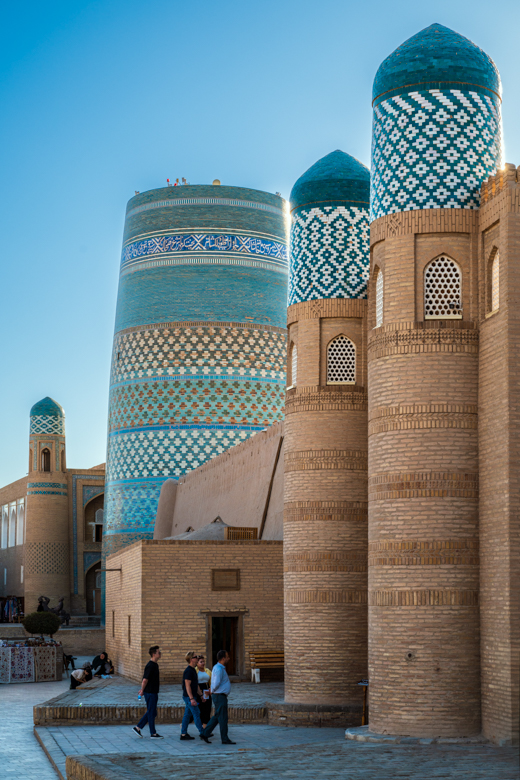
- Tickets: No tickets are required here.
- Timings: No such strict time frame.
- Pro tip:
- The best time to visit the Kalta Minor is at dawn. The plaza remains empty and you will only have pigeons and doves for company.
- For photography, dawn and sunset are perfect. The rising sun paints the turquoise tiles with a sublime glow, while the setting sun ricochets a warm, pinkish tone. Watch the Kalta Minor from the top of the Kuhna Ark during sunset.
- Don’t forget to visit the minaret in the evening when it’s illuminated to a surreal effect.
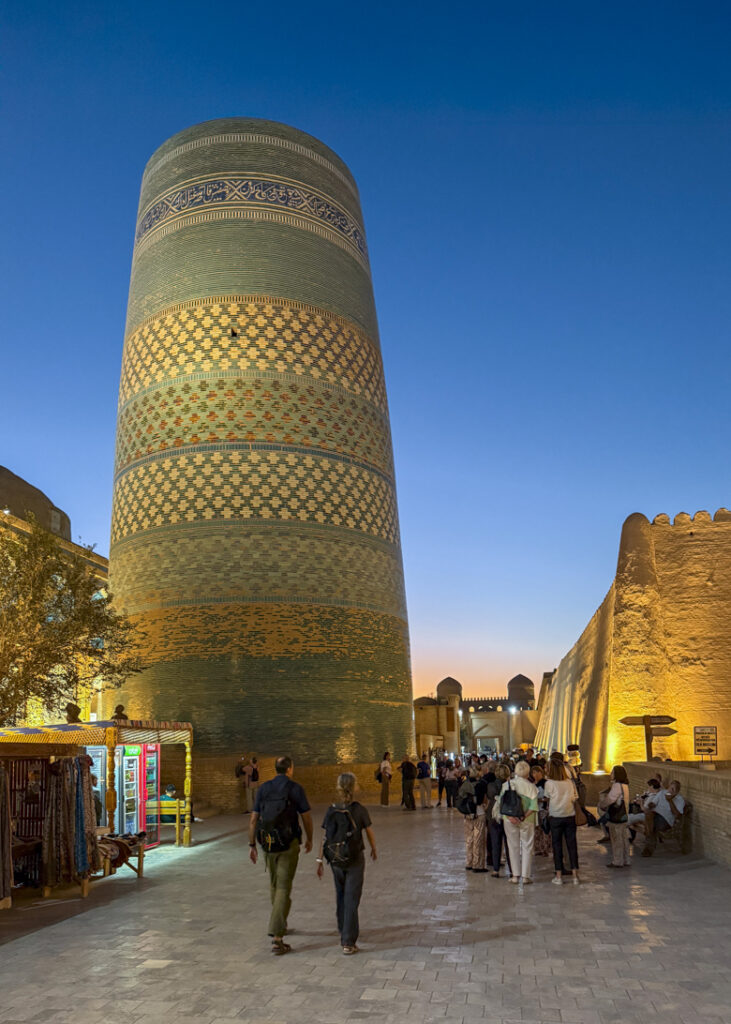
Mohammad Amin Khan Madrassa:
Situated beside the Kalta Minor, this madrassa is now converted into a heritage hotel (Orient Star Khiva). The interior has been grossly modified, so admire the monument from the outside.
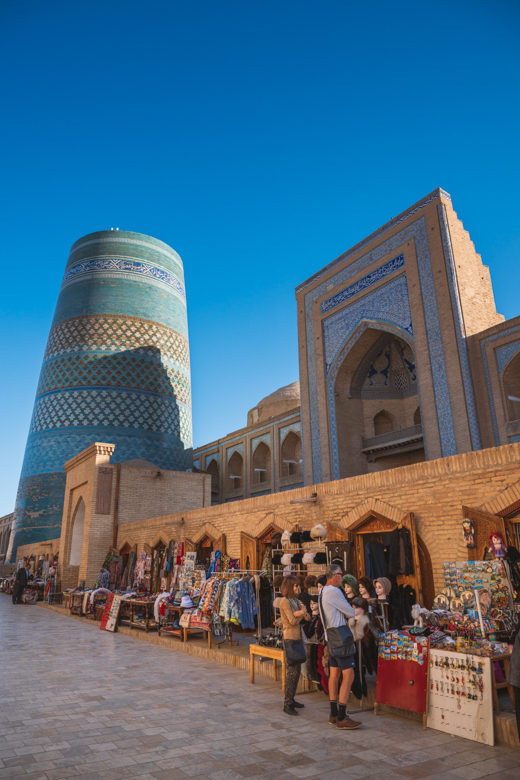
Kuhna Ark Watchtower:
To the left of the West Gate of Itchan Qala stands the Kuhna Ark, the residence of Khiva’s rulers. The Watchtower of the Ark offers a breathtaking 360-degree view of the city. The scene turns more spectacular during the sunset. You can watch the monuments and minarets of Khiva basking under the rays of the setting sun.
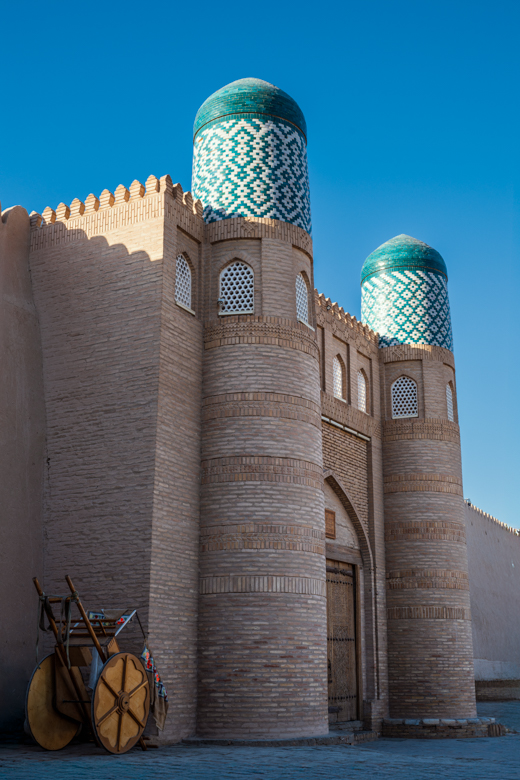
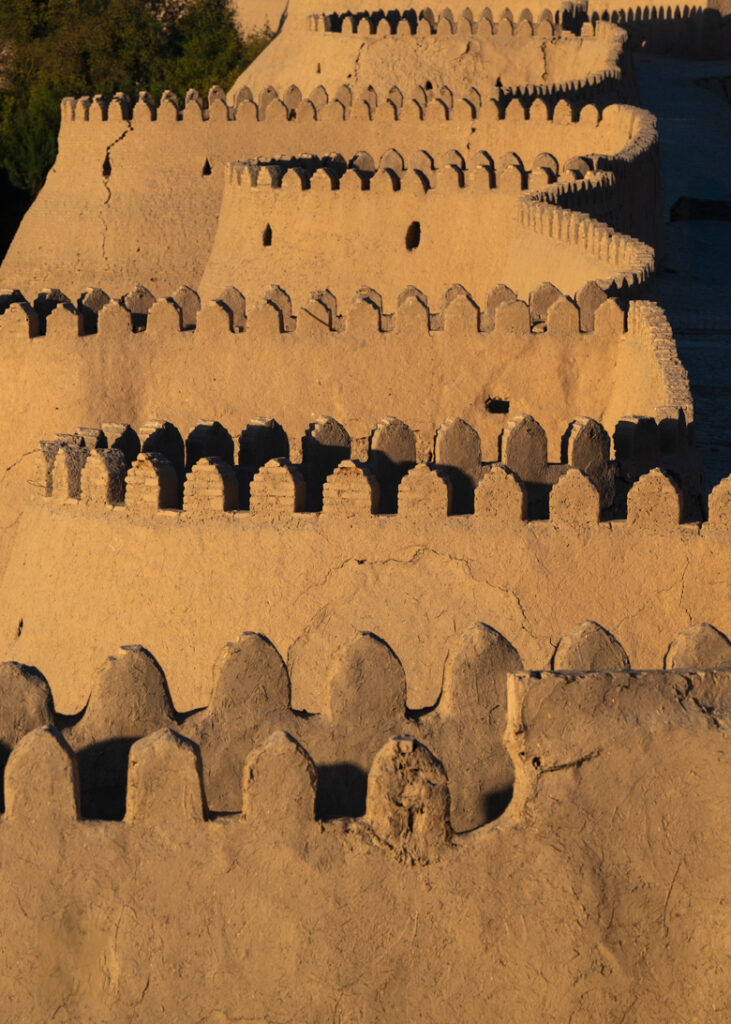
- Timing: Every day from 8 AM to 8 PM.
- Tickets: The Itchan Qala entry ticket does not work here. You have to purchase a different ticket to climb the watchtower. The ticket costs UZS 80,000 per person.
- Pro tip:
- The best time to visit the Kuhna Ark watchtower is during the sunset.
- For photography, the sunset is the ideal time.
During sunset, the Kuhna Ark gets packed with tourists and locals. In addition, young couples line up here for their pre-wedding photoshoot. Hence, reach the watchtower by 5 PM to get a perfect spot for photography.
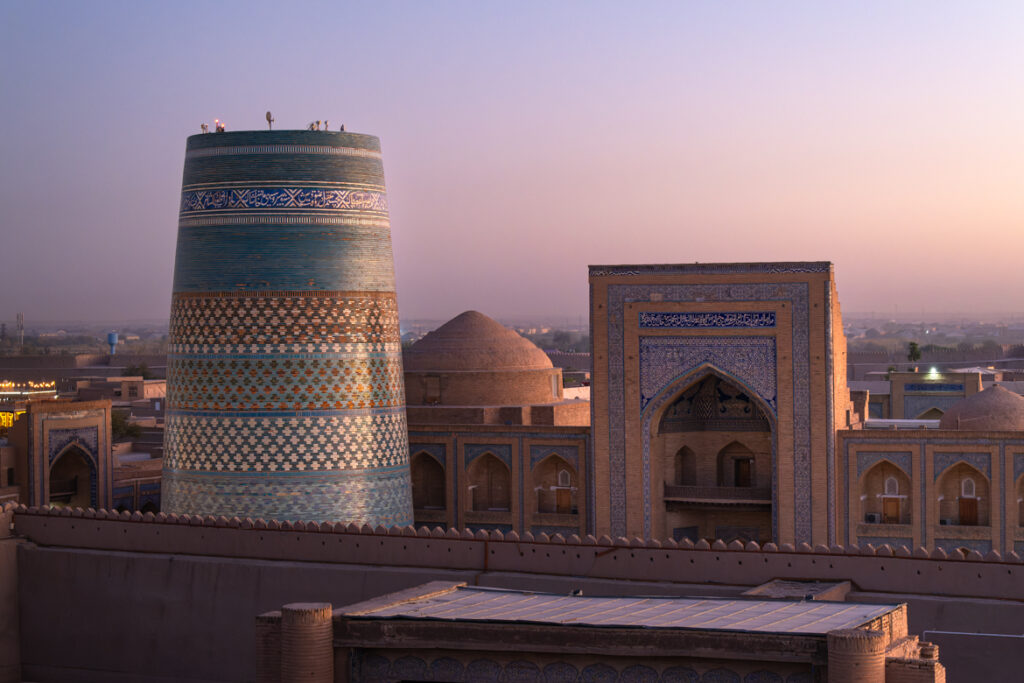
Stay even after the sun has set and visitors have left. The town of Khiva lighting up gradually is a sight to behold.
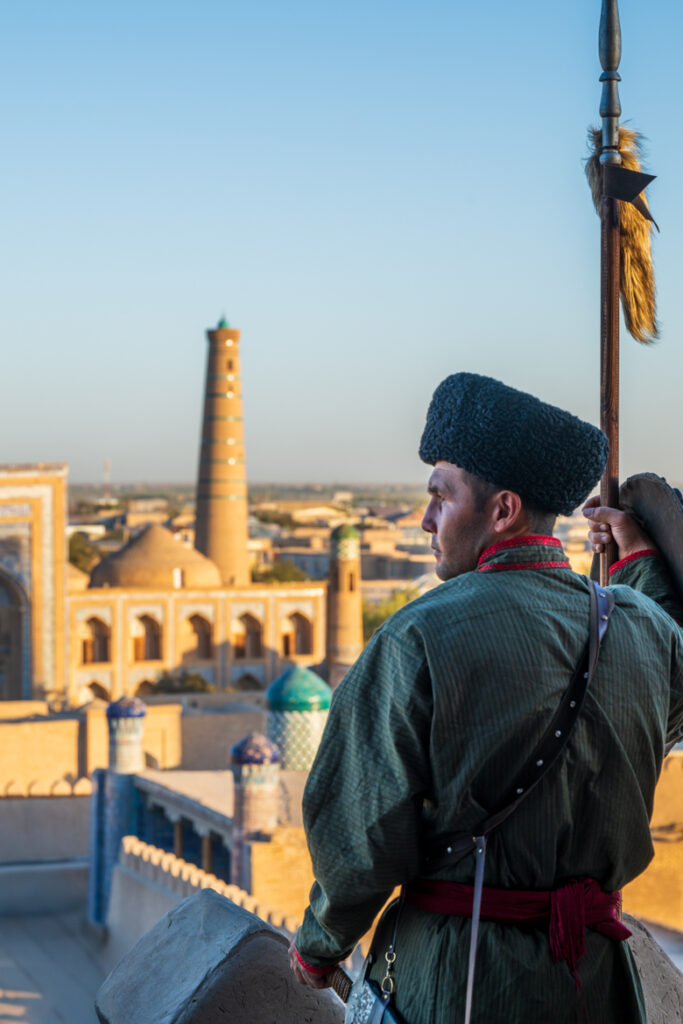
Kuhna Ark Palace:
This palace, which once served as the royal residence of the Khiva’s rulers, is the largest monument in Itchan Qala. Built in the 12th century CE by Ok Shayk Bobo, the Kuhna Palace is a maze of rooms, corridors, and courtyards.
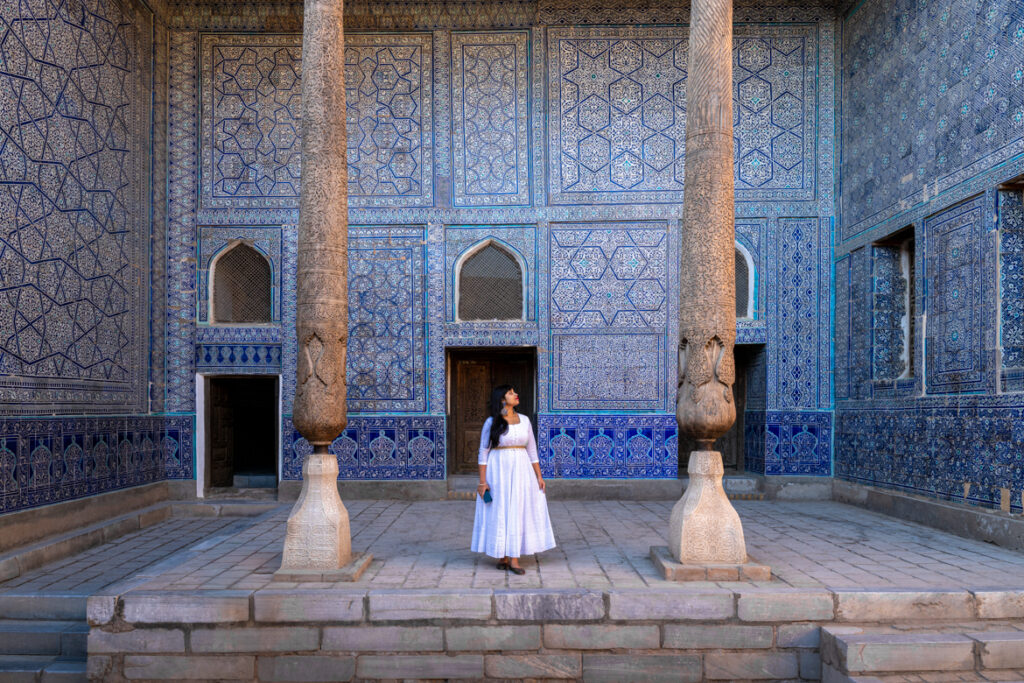
The palace consisted of the Khan’s residence, harem, state offices, greeting room, mint, mosque, armoury, ammunition workshop, storehouse, kitchen, stable, dungeon, and an arena for fighting rams.
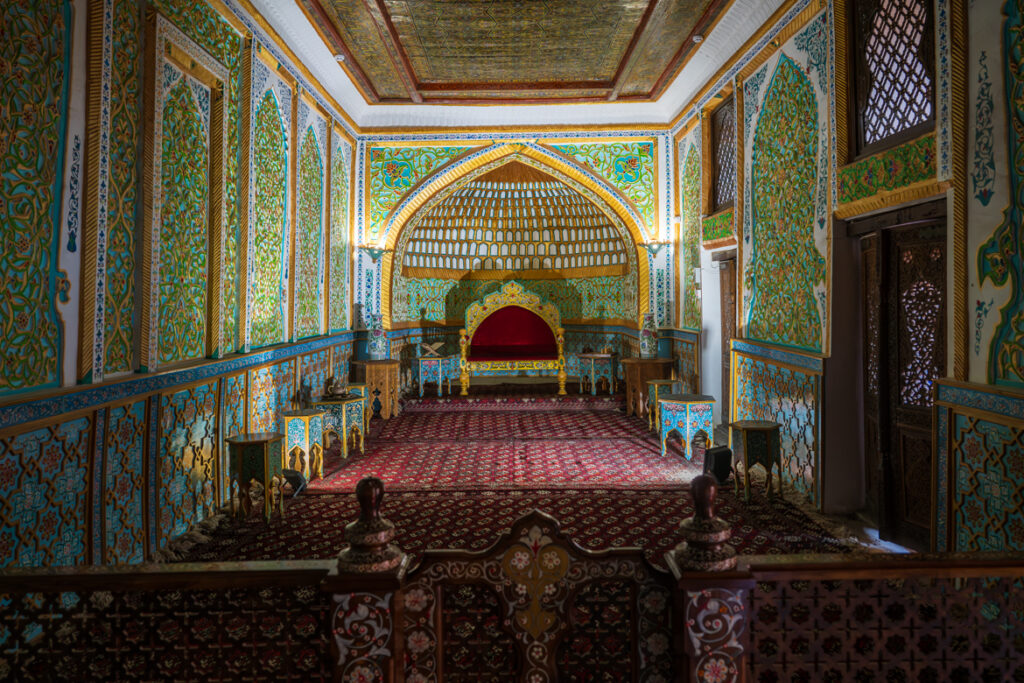
The Kuhna Palace offers an intimate glimpse into the lives of the Khans. Moreover, the complex is embellished with exceptional tile work. Also, there is an excellent museum that showcases the history of the Khorezm right from the Palaeolithic Age.
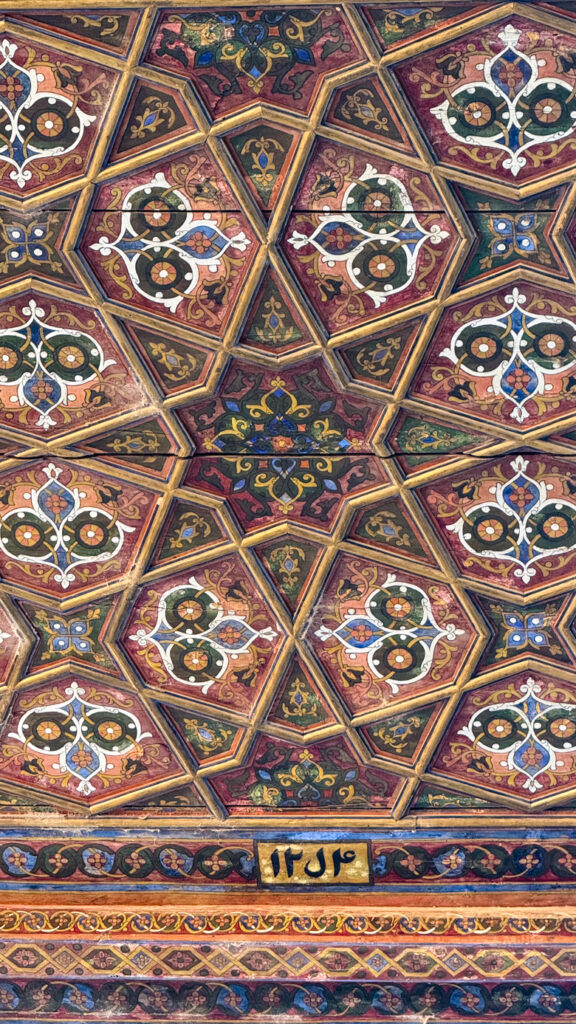
- Timings: Every day from 8 AM to 6 PM.
- Tickets: You have to show the entry ticket of Itchan Qala.
- Time required: At least an hour.
- Pro tip:
- The best time to visit is right after the palace door has been opened. You will only find the caretakers inside and no tourists.
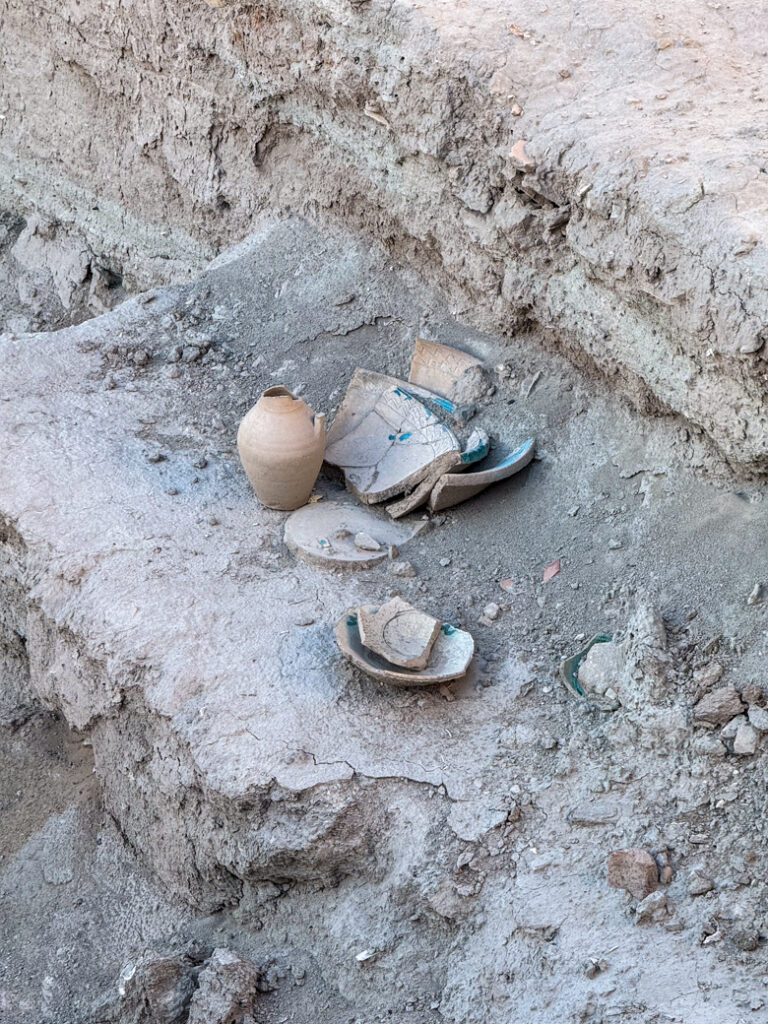
Mohammad Rakhim Khan Madrassa:
This pleasing madrassa lies just across the Kuhna Ark Palace. It was named after the Khan who had surrendered to Russia in 1873 CE.
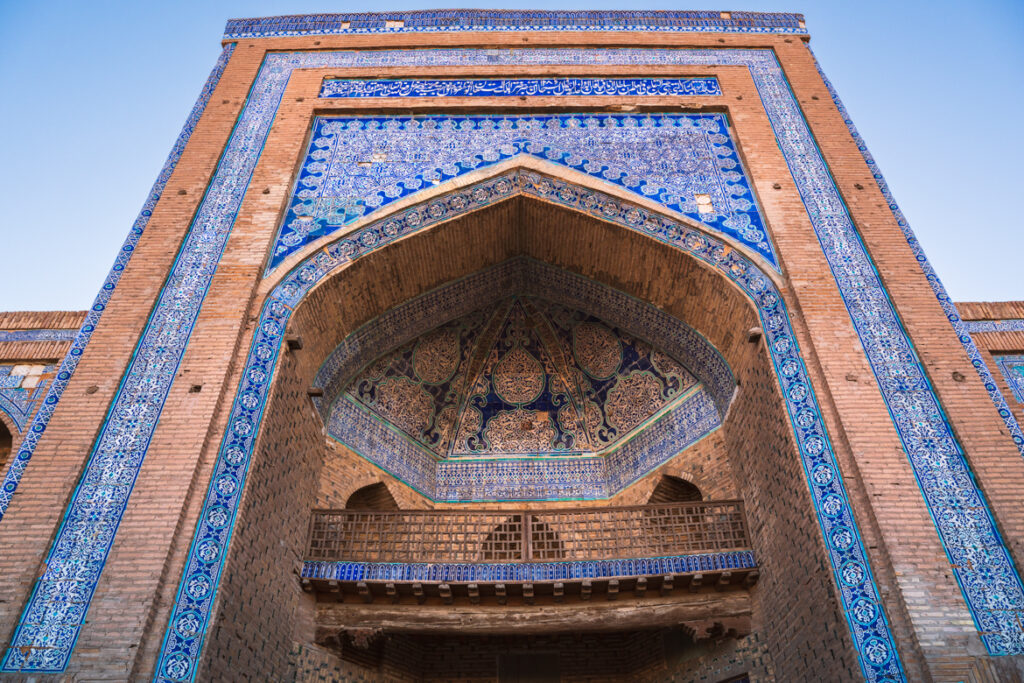
In the evening, traditional music and dance programmes are organised on request in its courtyard.
Juma Mosque:
One of the most fascinating monuments of Itchan Qala, the Juma Mosque is adorned with 218 wooden pillars, an idea borrowed from an ancient Arabian mosque. The wooden pillars are intricately carved, and each pillar is furnished with a different design. Few of the columns belong to the original 10th-century mosque, which has now been barricaded.
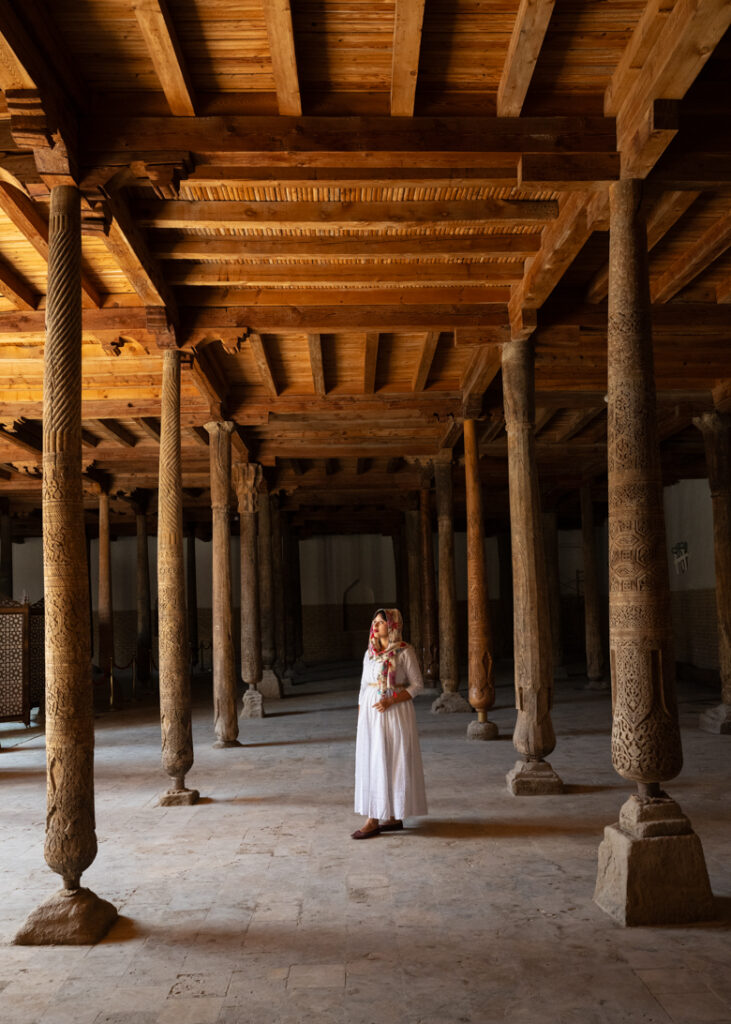
- Timings: Every day 9 AM to 6 PM.
- Tickets: No separate ticket is needed here. Just show your Itchan Qala entry ticket.
- Time required: An hour or so.
- Pro tip:
- The best time to visit is afternoon when the light inside is perfect and the crowd is thinner.
- For photography, visit in the afternoon when the light and shadow are in play inside. The Juma Mosque offers exciting photographic opportunities.
Women need to cover their heads inside the mosque, so carry a scarf or shawl.
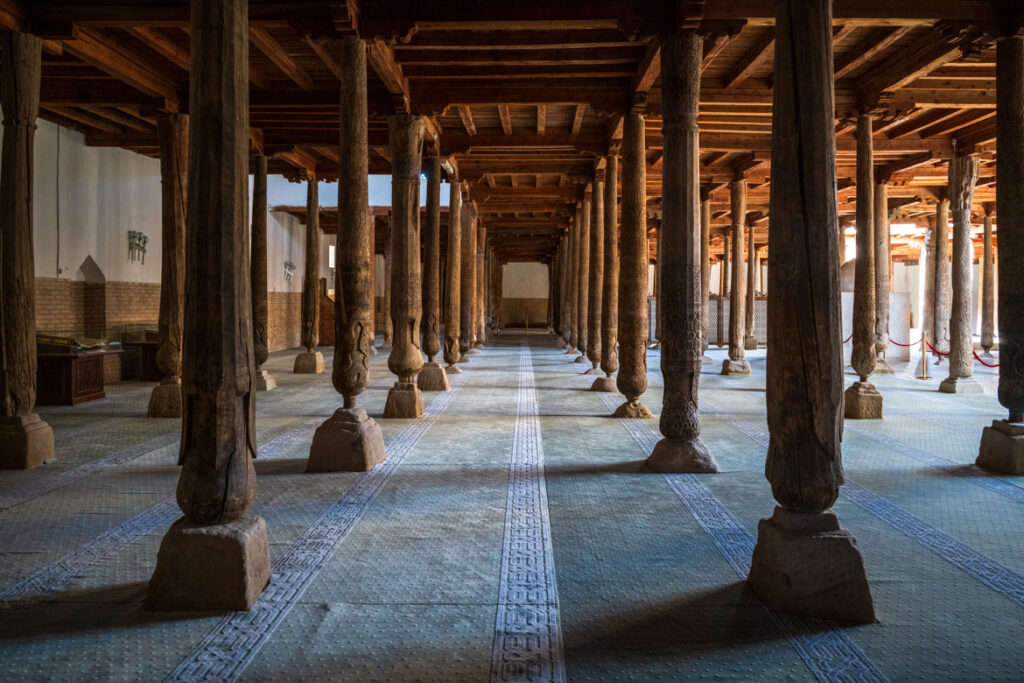
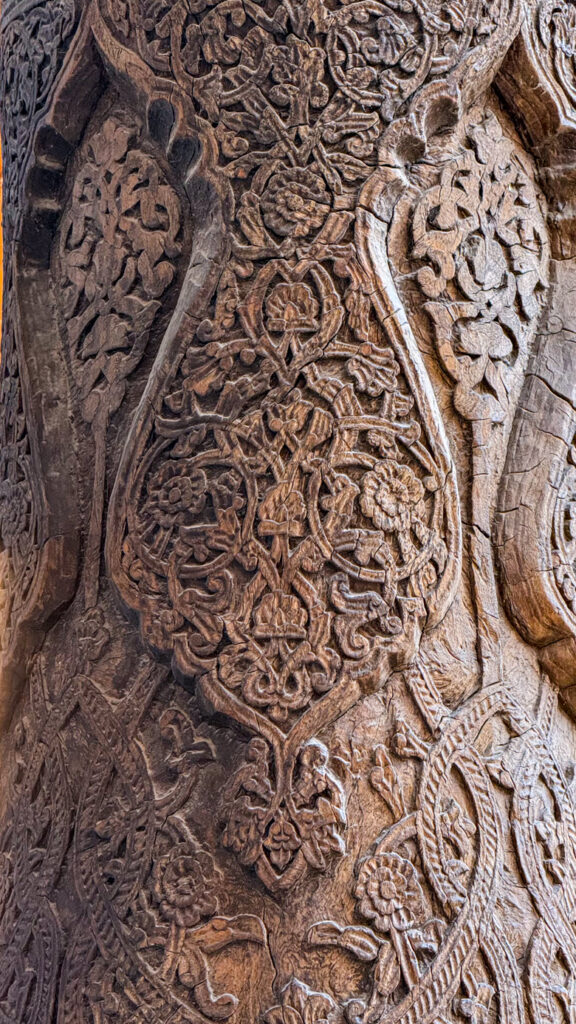
Wear modest clothes (applicable for all genders) as this is a place of worship.
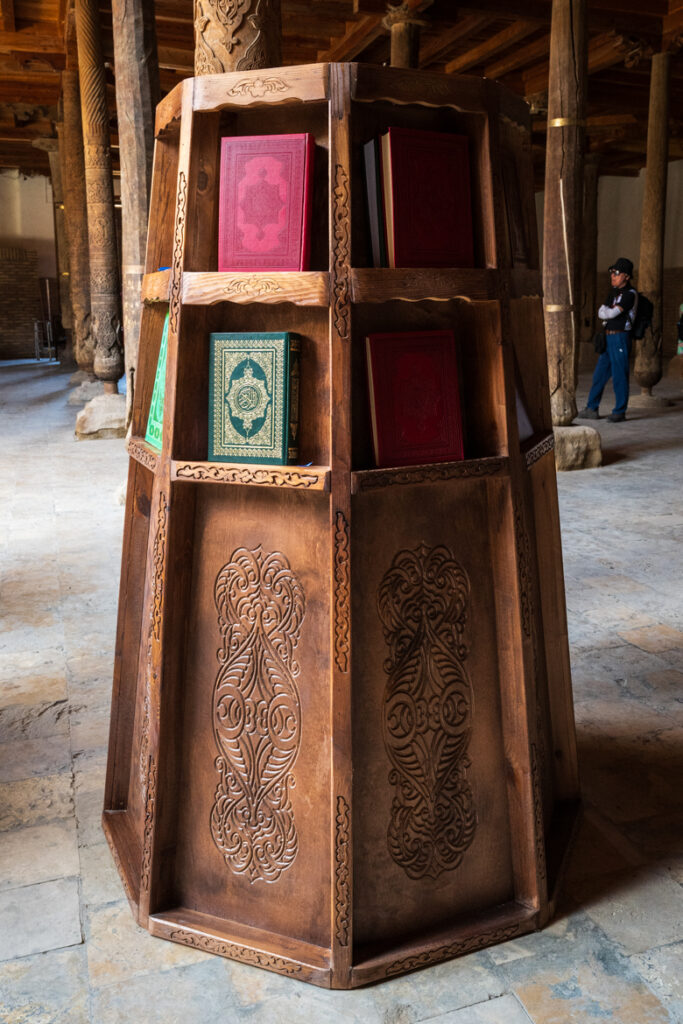
Tosh Hovli Palace:
The words ‘Tosh Hovli’ means stone house. It used to be the summer palace of Khiva’s Khan.
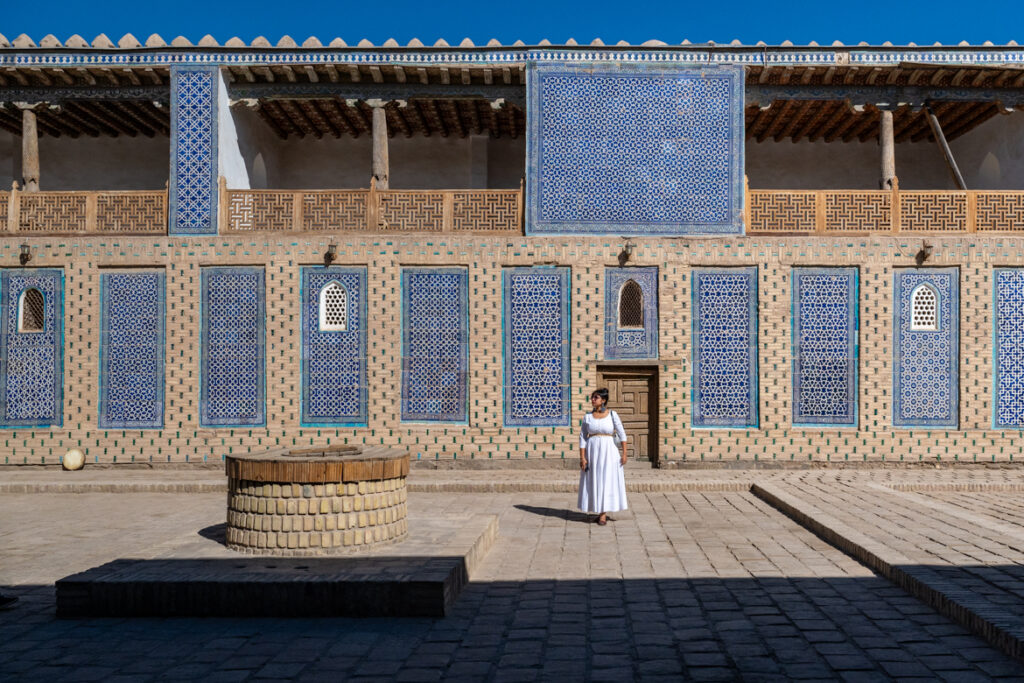
The palace was built between 1832 and 1841 CE under the patronage of Allakuli Khan, who is renowned as the ‘builder Khan’ and credited with the creation of many of Khiva’s monuments.
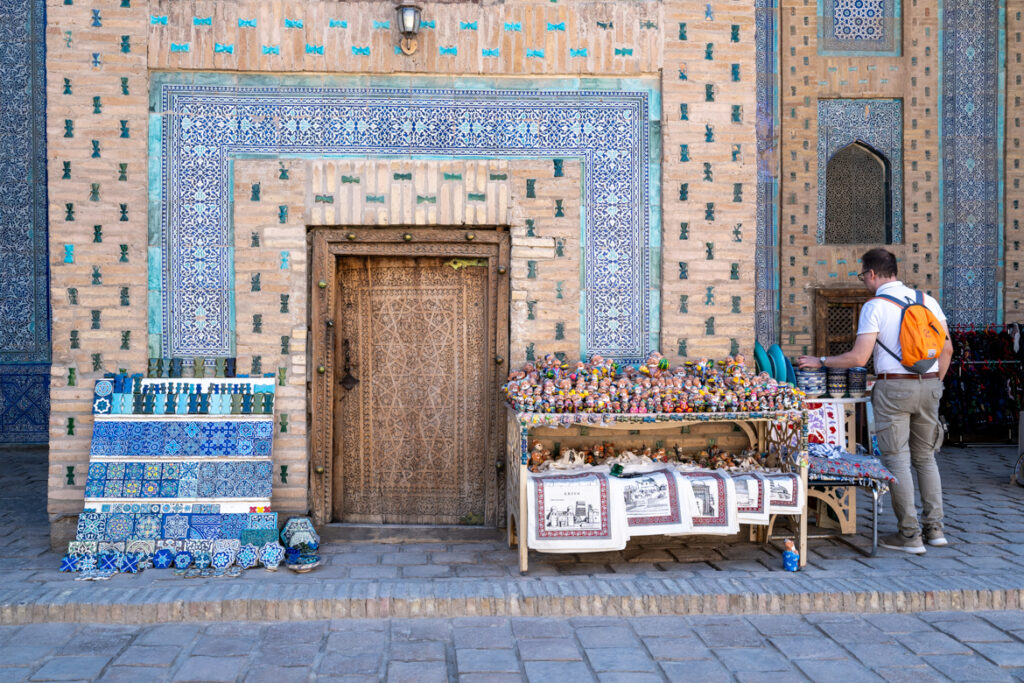
The Tosh Hovli Palace is arguably the most splendid attraction of Khiva. It is graced with an exquisite interior, teeming with carved wooden pillars, blue ceramic tiles, and ‘ghanch’. The palace had more than 150 rooms and 9 courtyards.
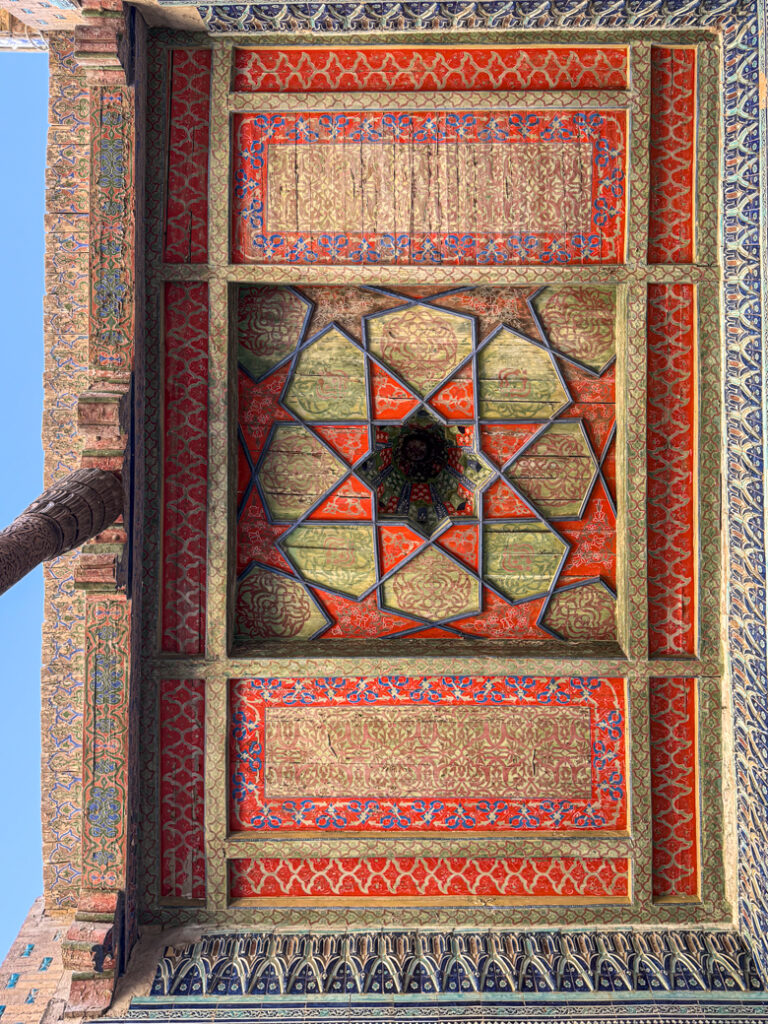
- Timings: Every day 9 AM to 6 PM.
- Tickets: The Itchan Qala entry ticket will suffice here.
- Time required: More than an hour.
- Pro tip:
- The best time to visit is in the morning. Try to reach before 10 AM and you will find the palace all to yourself (mostly).
Pakhlavon Mahmud Mausoleum:
The versatile Pakhlavon Mahmud is revered as the patron saint of Khiva. He was a 14th-century humanist philosopher, poet, wrestler, and craftsman. He was buried in his modest workshop, which soon became a pilgrimage site. It is still an active place of worship. You will find locals praying silently inside, or a newlywed couple has arrived with their wedding party to seek blessings for their new journey.
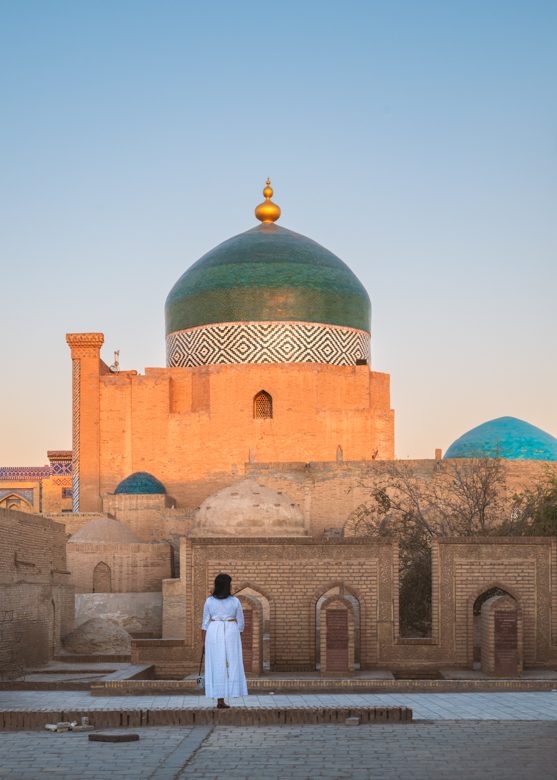
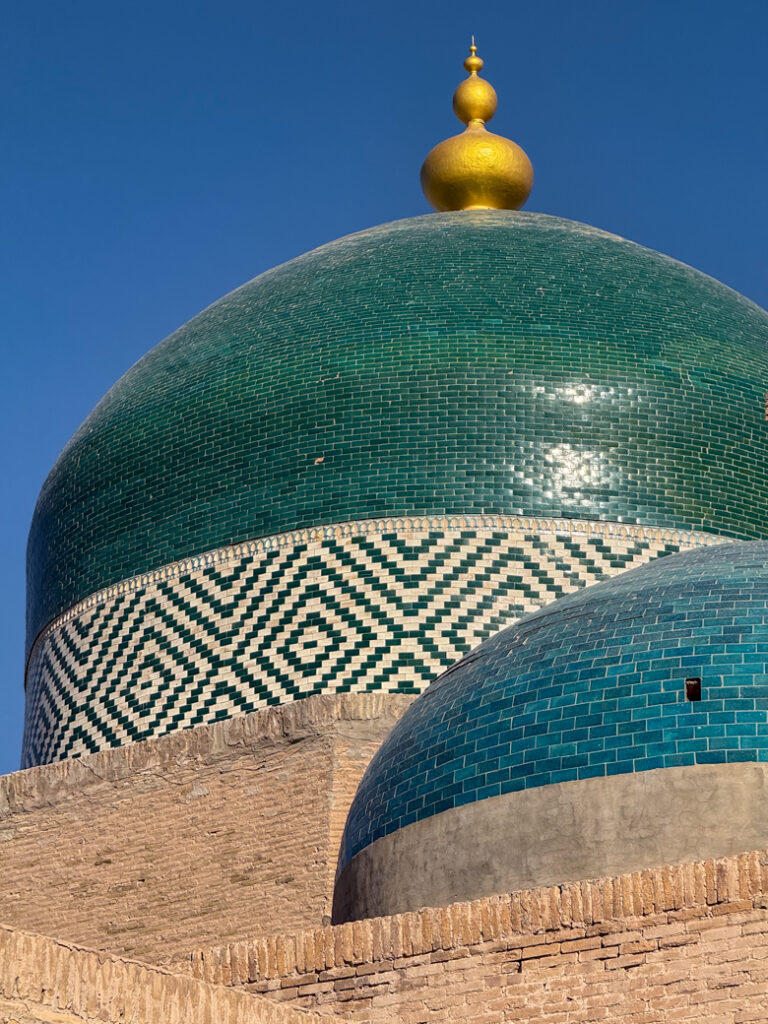
The mausoleum is distinguished by its colossal turquoise dome. The interior is lavishly decorated with exceptional tile work, majolica, and wood inlays.
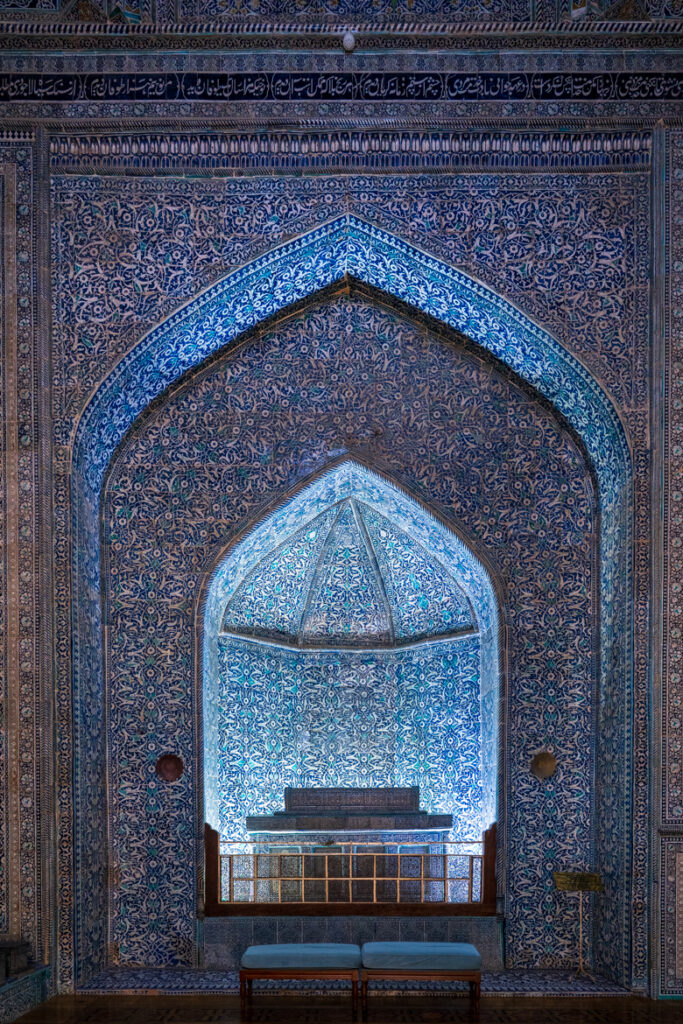
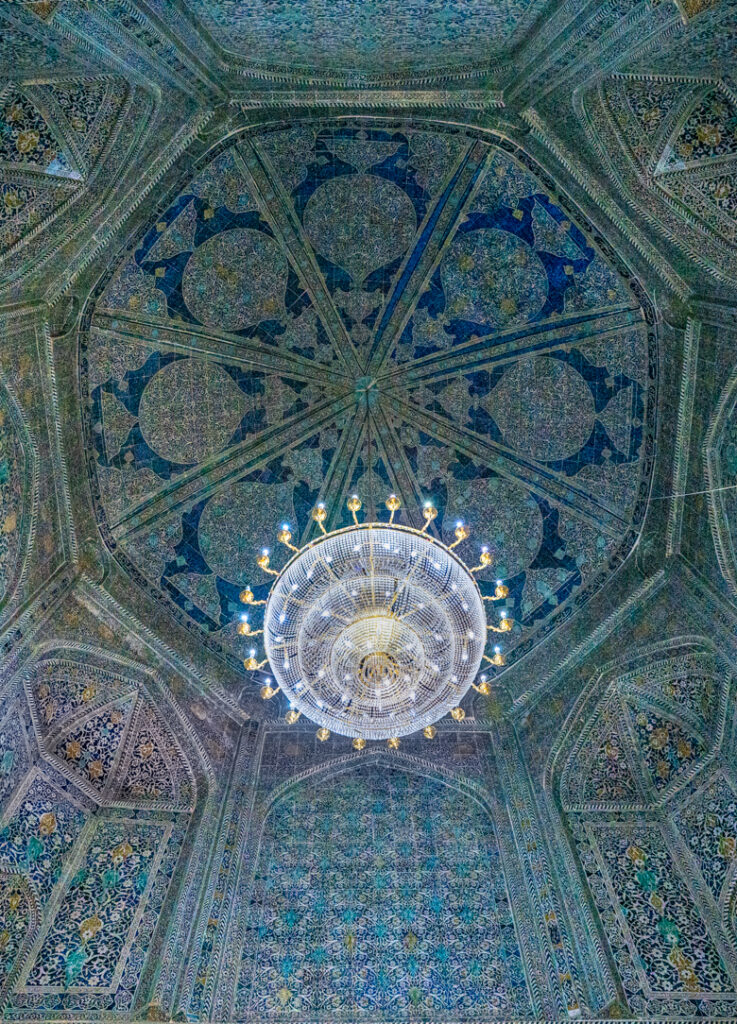
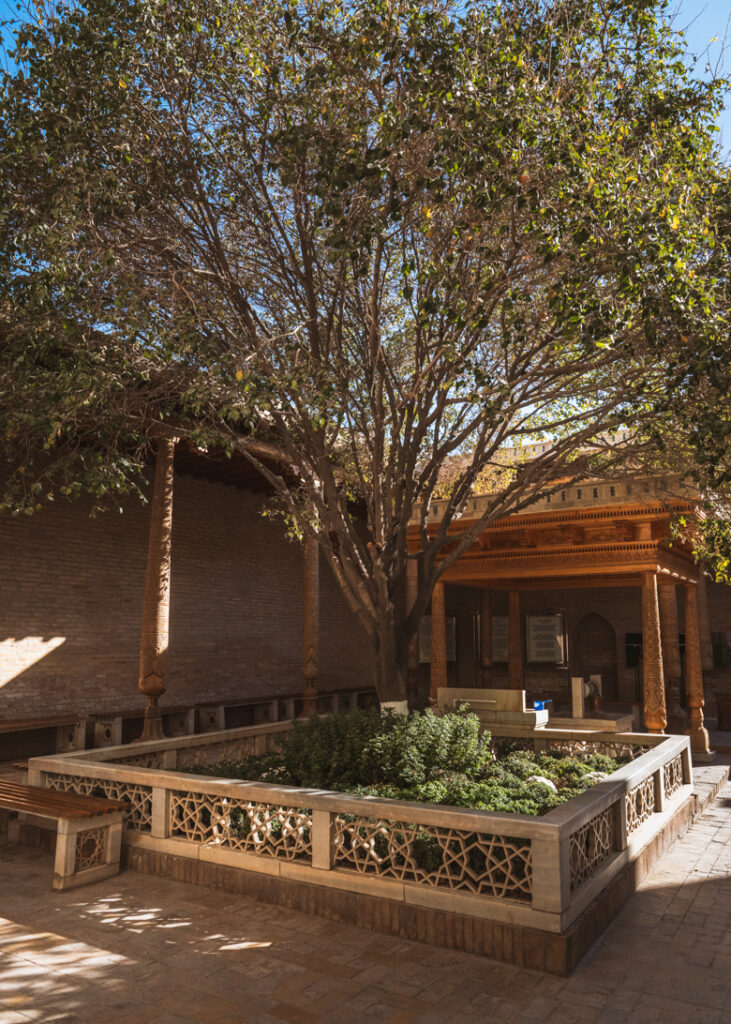
- Timings: Every day from 8 AM to 8 PM.
- Tickets: The entry fee is UZS 40,000.
- Time required: An hour at least.
- Pro tip:
- The best time to visit is in the hours leading to the sunset when the mausoleum remains less crowded.
- For photography, visit during the sunset when the mausoleum turns sublime under the soft light. Also, the hordes of tourists will be absent.
- Women need to cover their heads here, so carry a scarf or shawl.
- Maintain silence and follow the decorum as this is an active place of worship.
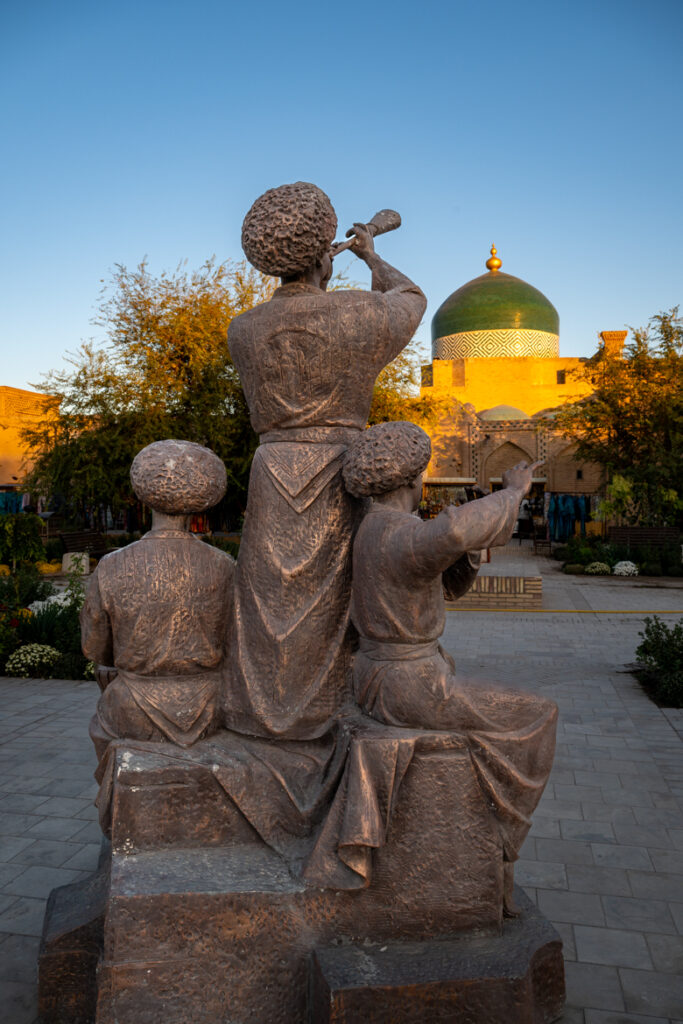
Islam Khoja Madrassa & Minaret:
Regarded as Khiva’s icon, the 57-metre Islam Khoja Minaret is Uzbekistan’s highest tower. Built in 1910, it was also the first site in Uzbekistan to be declared a UNESCO World Heritage Site. The top of the minaret provides a stunning view of Itchan Qala and can be reached by climbing as many as 175 stairs.
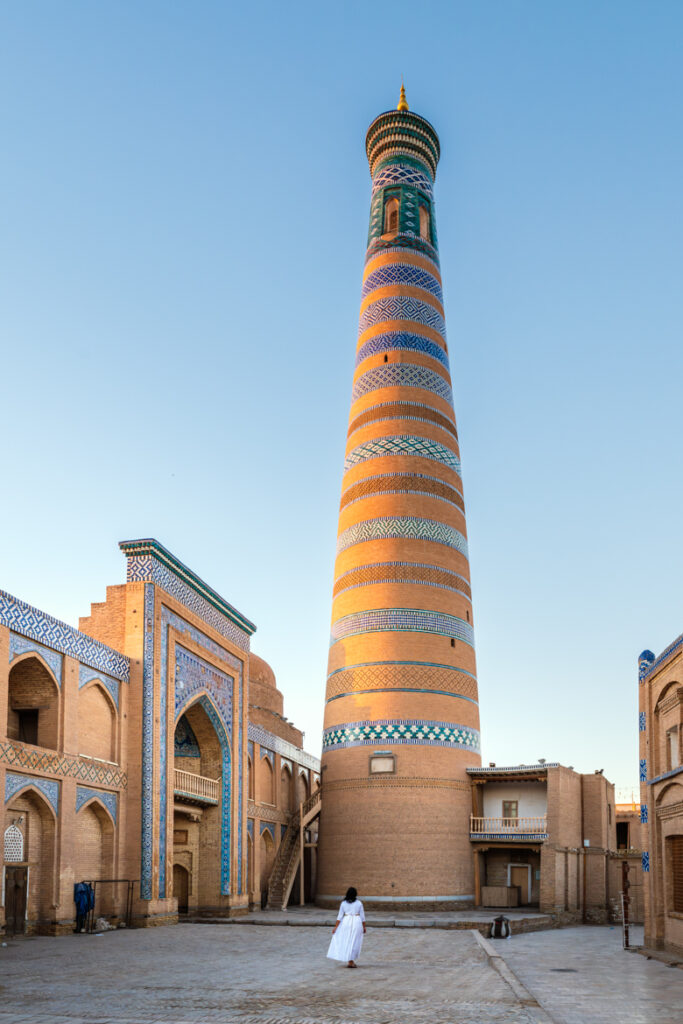
The Islam Khoja Madrassa hosts the Museum of Applied Arts, which displays Khorezm handicrafts through the ages.
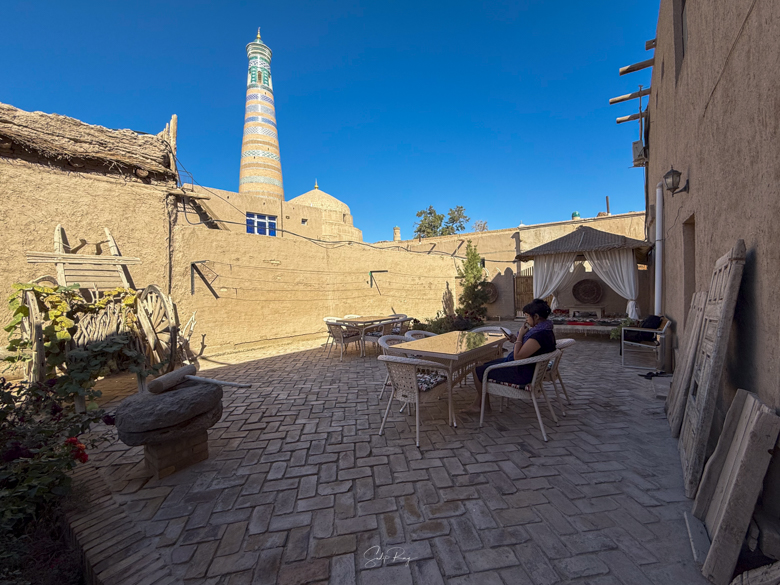
- Timings: The minaret can be admired from outside any time throughout the day. The madrassa and the top of the minaret can be visited from 8 AM to 6 PM.
- Tickets: A ticket is required only if you want to climb the minaret. It costs UZS 100,000.
- Time required: More than an hour.
- Pro tip:
- The best time to visit the Islam Khoja Minaret is at dawn. As the day progresses, the plaza surrounding the minaret gets crammed with shops and swarmed with tourists.
- For photography, go in the early morning when the plaza is empty and evening when the minaret is spotlit.
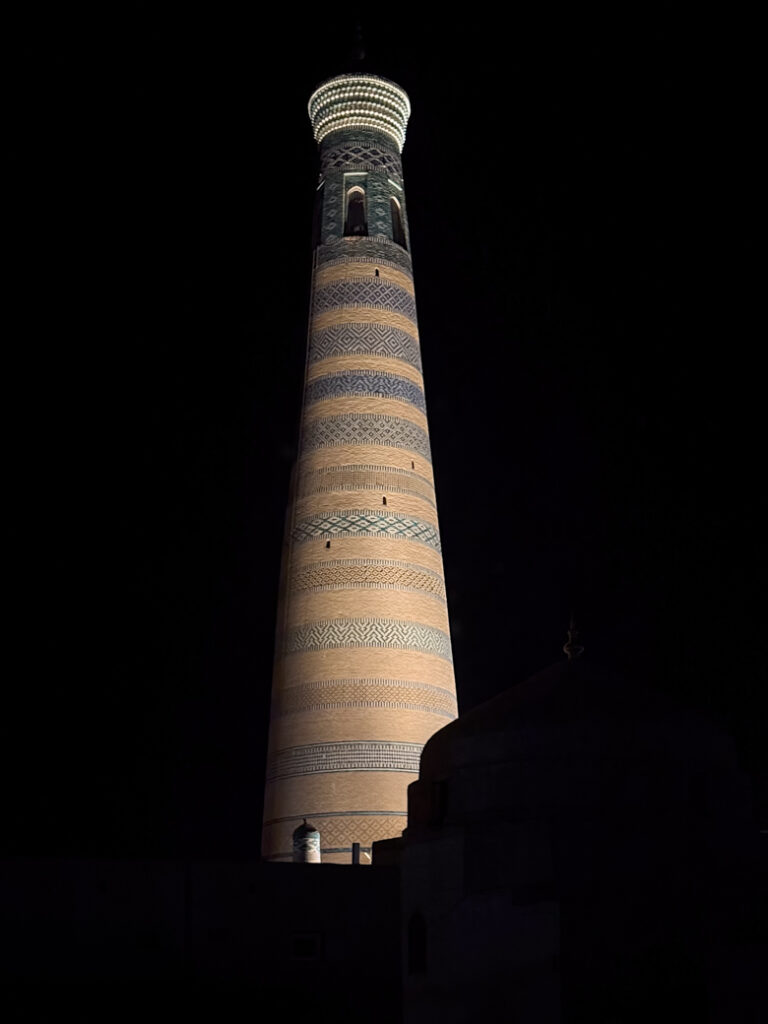
Apart from visiting the old town’s historic monuments, wander through the winding alleys of Itchan Qala. Walking on the cobbled streets feels like stepping back in time. You will also come across a host of minor madrassas such as Allakuli Khan Madrassa, Abdulla Khan Madrassa, Kutlug Murod Inoq Madrassa, and Allakulli Khan Bazaar and Caravanserai.
Isfandiyar Palace:
Locally known as the Nurullabay Palace, it is located in Ditchan Qala or the outer city of Khiva. It was built by Mohammad Rahim Khan in 1906. He was inspired to build this grand palace after visiting St. Petersburg.
How many days are required for Khiva:
You will need two days to explore Khiva thoroughly. Like Samarkand and Bukhara, a few spots in Khiva demand a second visit in the evening when the monuments are illuminated. We spent two full days in Khiva and explored every nook and cranny of the Itchan Qala.
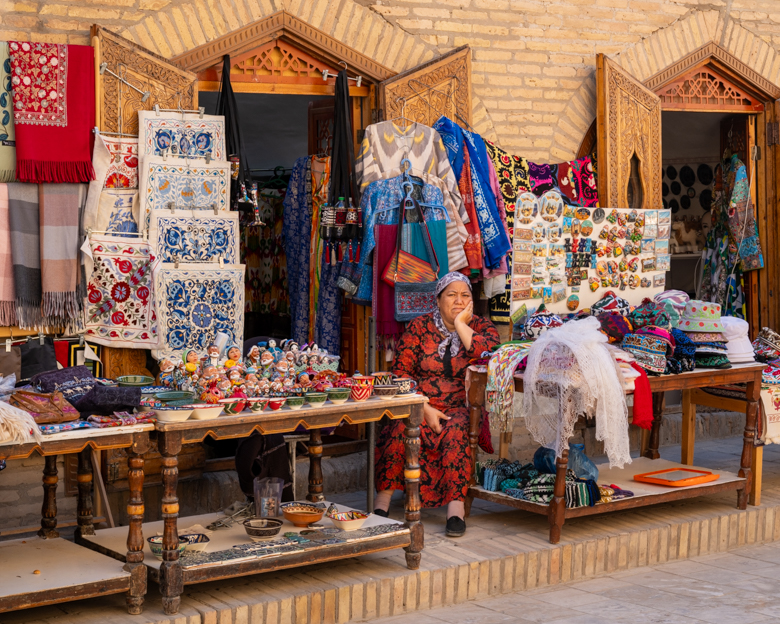
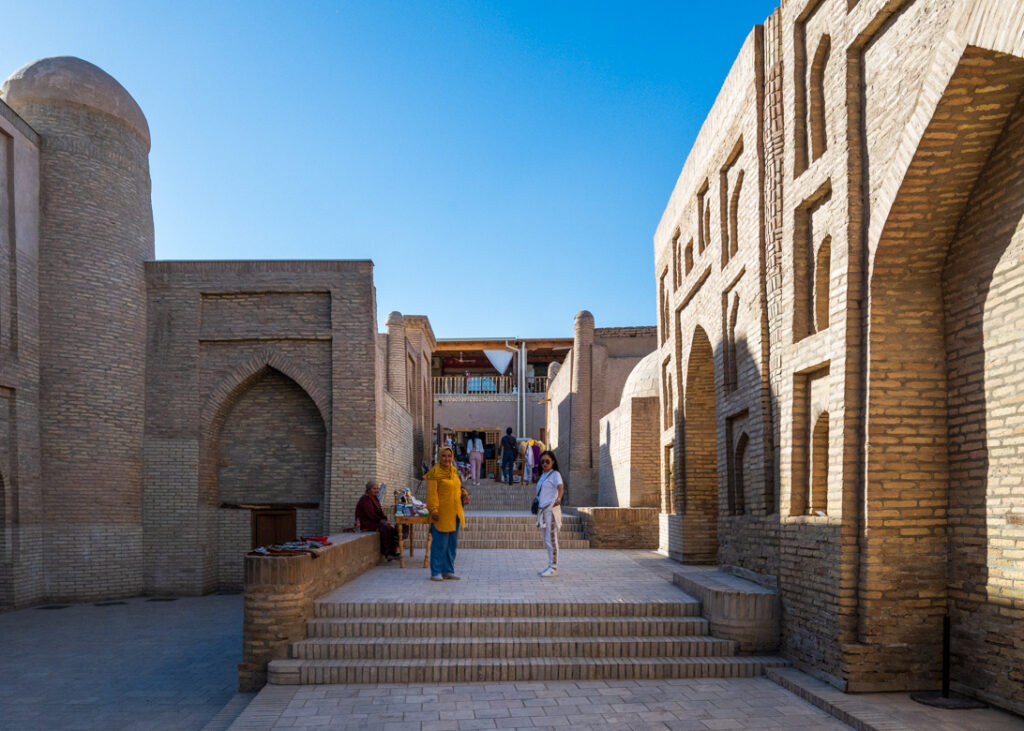
2-day itinerary for Khiva:
Start with getting your ticket at the West Gate of Itchan Qala. Then visit Kalta Minor, Mohammad Amin Khan Madrassa, and Juma Mosque, walk the alleys, and finish with sunset at the Kuhna Ark watchtower.
Kick off your second day at dawn. First visit the Islam Khoja Minaret and Kalta Minor, followed by Kuhna Ark Palace and Mohammad Rakhim Khan Madrassa. Post-breakfast, go to Tosh Havli and Pakhlavon Mahmud Mausoleum. After lunch, visit the Isfandiyar Palace.
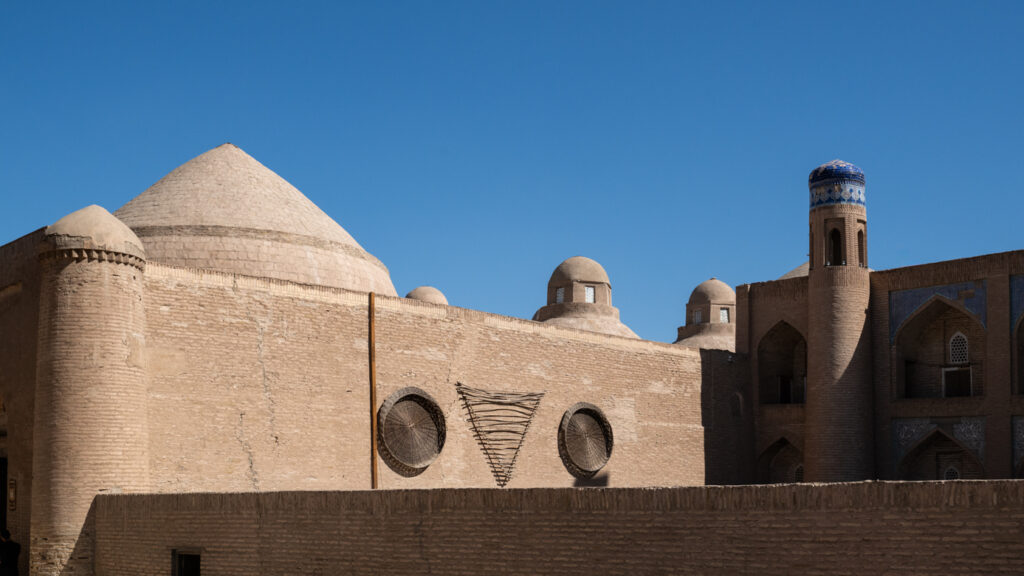
1-day itinerary for Khiva:
Visit the major attractions of Khiva such as Kalta Minor, Kuhna Ark Palace, Juma Mosque, Tosh Havli, Islam Khoja Minaret, and Pakhlavon Mahmud Mausoleum.
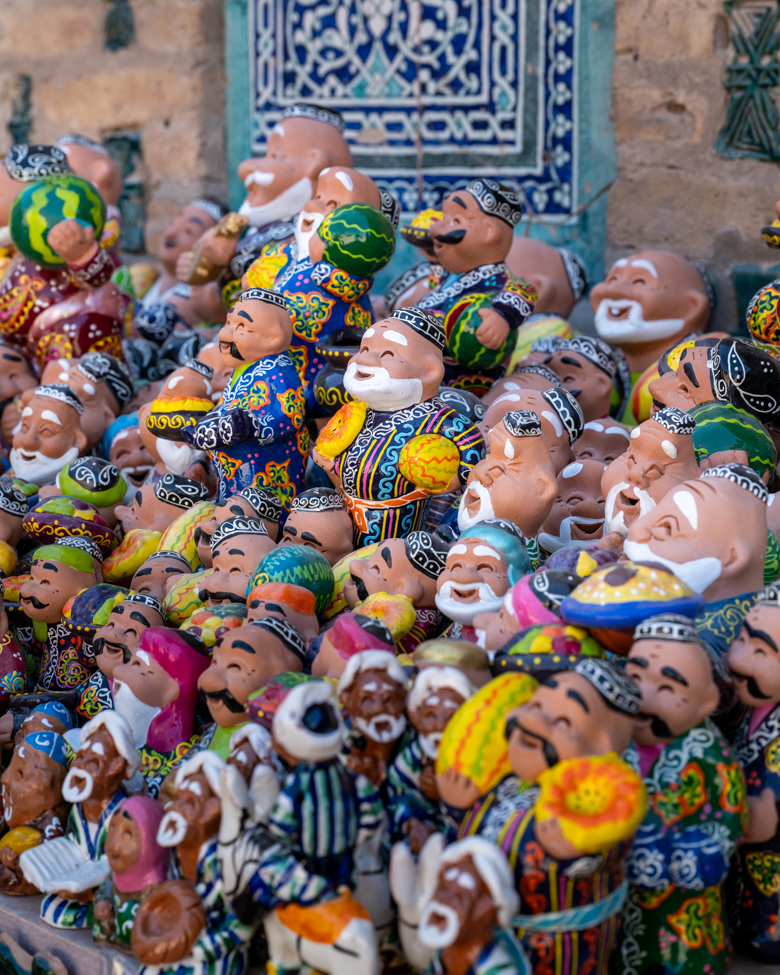
Trips from Khiva:
From Khiva, you can go on a few fascinating day trips.
Khorezm Desert Fortresses:
The desert around Urgench is dotted with enigmatic ruins of numerous walled towns, forts, and palaces. Traditionally called Elliq Qala (Fifty Fortresses), UNESCO has labelled this area as the ‘Golden Ring of Ancient Khorezm’. The most riveting ones are Toprak Qala (main temple complex of the Khorezm kings along with remains of a Zoroastrian fire temple), Ayaz Qala (an impressive complex of three forts), Guldursun Qala (ruins of a 12th century fortified town), Koy Krylgan Qala (temple and observatory complex dating back to 4th century BCE), Dumon Qala, and Janbas Qala (used as a garrison for soldiers).
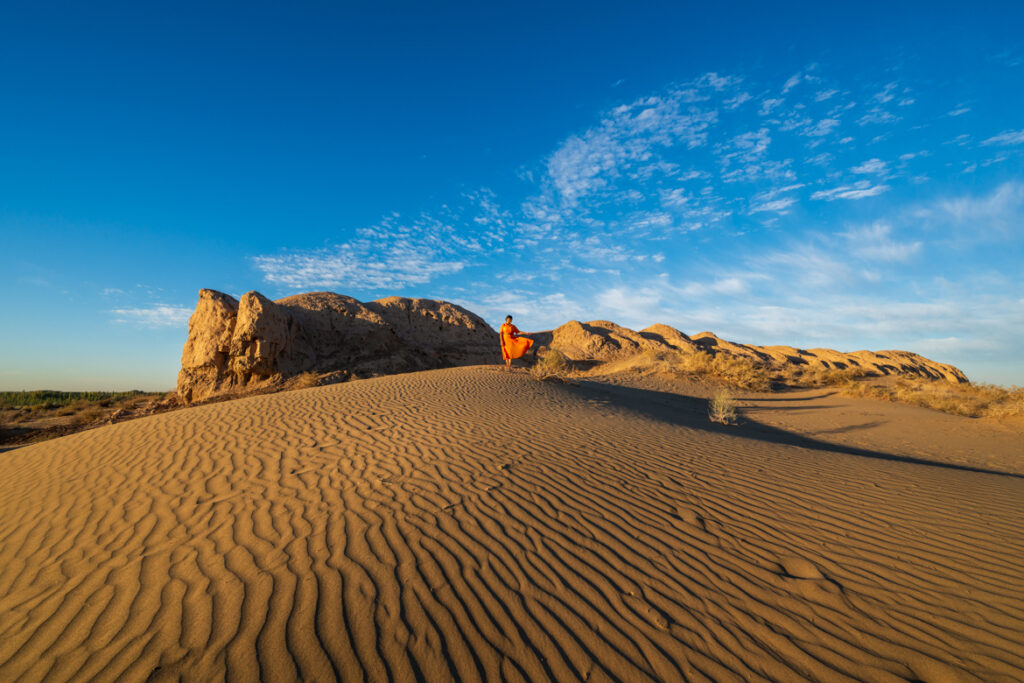
Reputed tour agencies of Khiva organise day trips to the desert fortresses. We suggest hiring the services of Islambek Travel. They have a host of itineraries for exploring the Khorezm fortresses.
We visited two desert fortresses (Dumon Qala and Guldursun Qala) on our way to Bukhara. The charge for this day trip was USD 79.
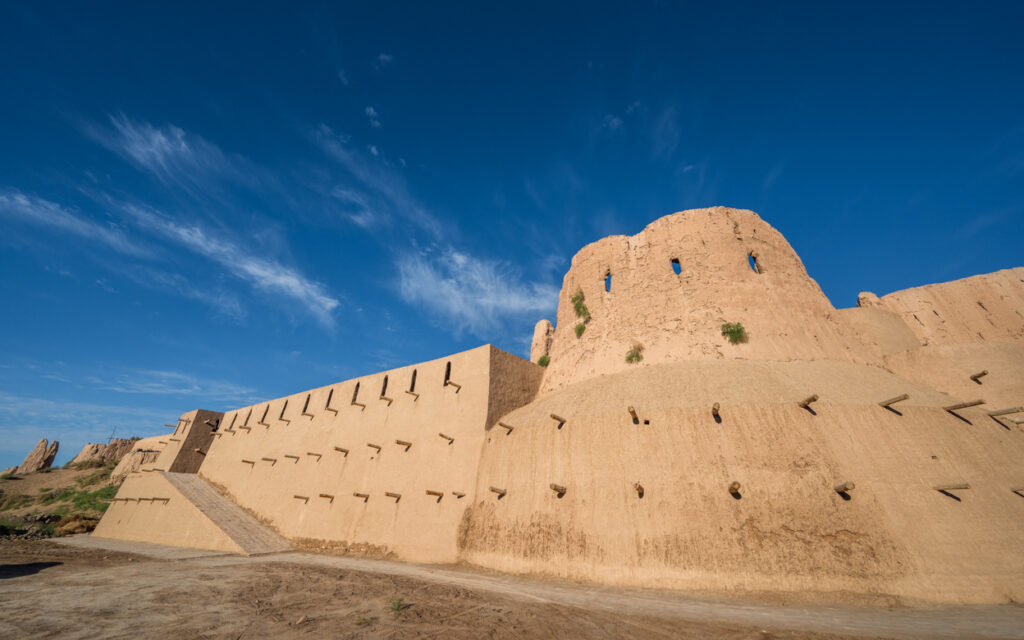
Aral Sea:
Once the fourth largest lake in the world, a manmade disaster has led to the shrinking of the Aral Sea. A 2-day trip from Khiva includes a visit to Nukus, Moynaq Ship Cemetery, Sudochie Lake, and Ustyurt Canyons. You can relish a night stay at yurt camps.
For the Aral Sea, you can book your trip with Islambek Travel. They have 5 tour plans starting from USD 350 for two persons.
Important FAQs:
Where is Khiva located?
Khiva is located in the Khorezm region of Uzbekistan, near the border of Turkmenistan. The approximate distances of other Uzbek cities are:
- Tashkent – 992 km
- Samarkand – 692 km
- Bukhara – 446 km
- Andijan – 1,276 km
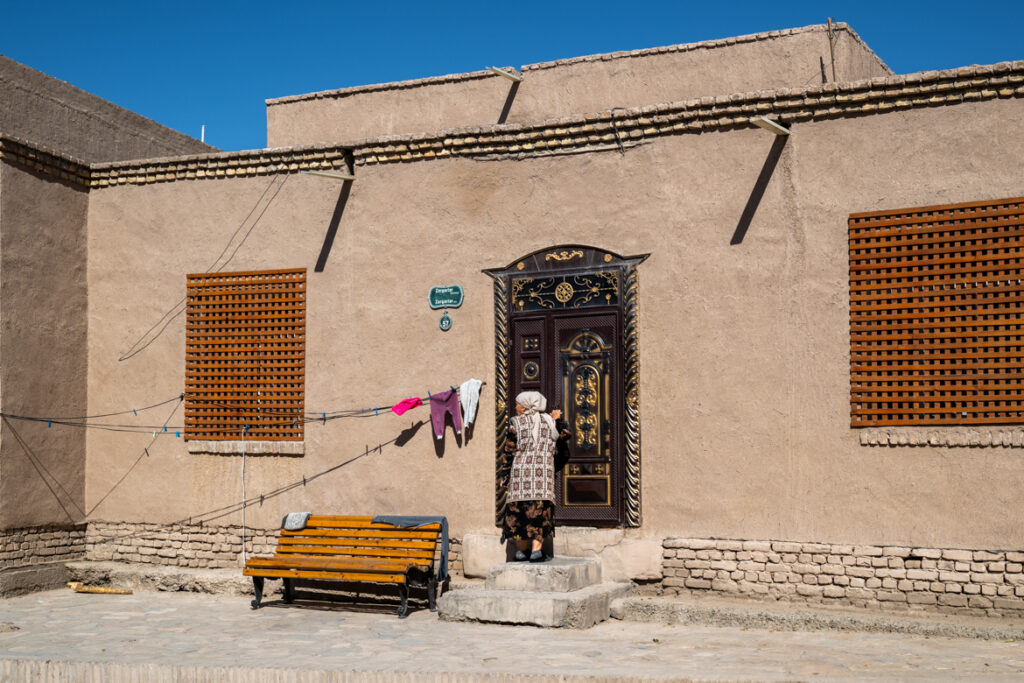
How can I reach Khiva?
By train: The high-speed Afrosiyob trains are not available for Khiva. The overnight sleeper trains from Tashkent, Samarkand, and Bukhara are the most convenient way to travel to Khiva. Tickets can be booked from the official website of Uzbekistan Railways.
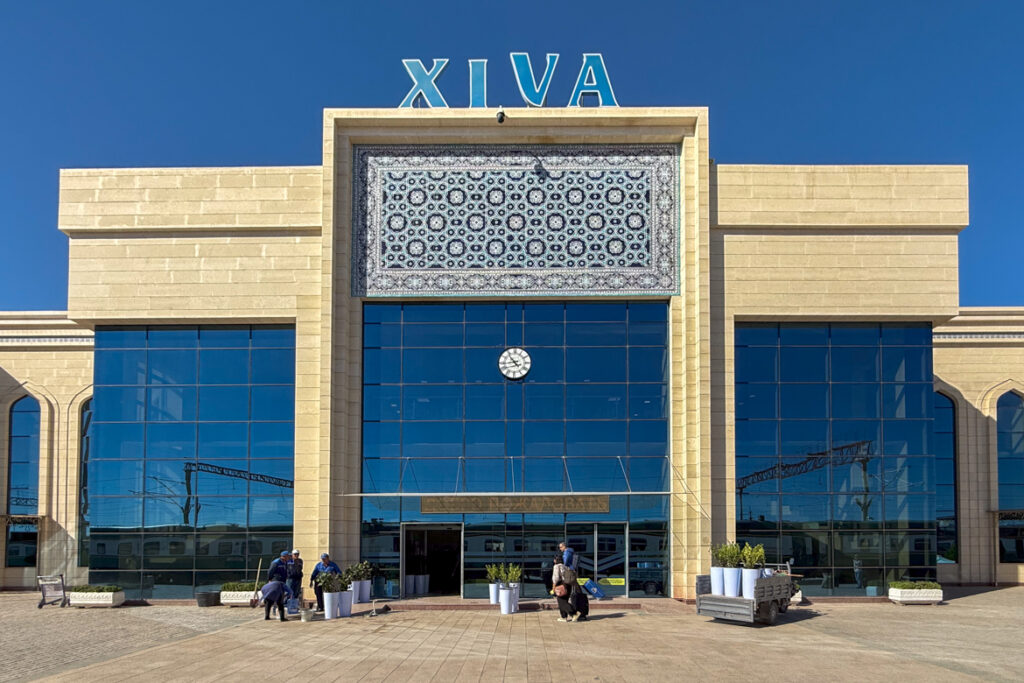
By flight: The nearest airport is Urgench, a 30-minute drive from Khiva. Regular flights are available from Tashkent. Check the website of Uzbekistan Airways as flight schedules often change.
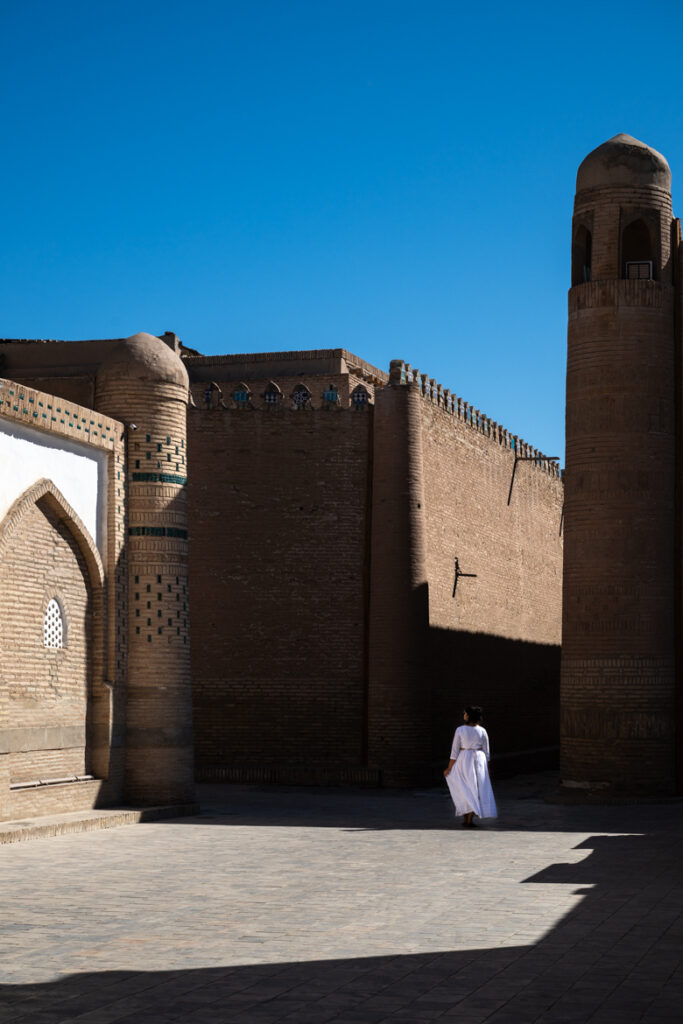
What is the best time to visit Khiva?
Spring (March to May) and autumn (September to mid-November) are the best time to visit. Avoid summer as temperature soars beyond 40 degrees Celsius. Also, winters are bitterly cold thanks to the Polar winds.
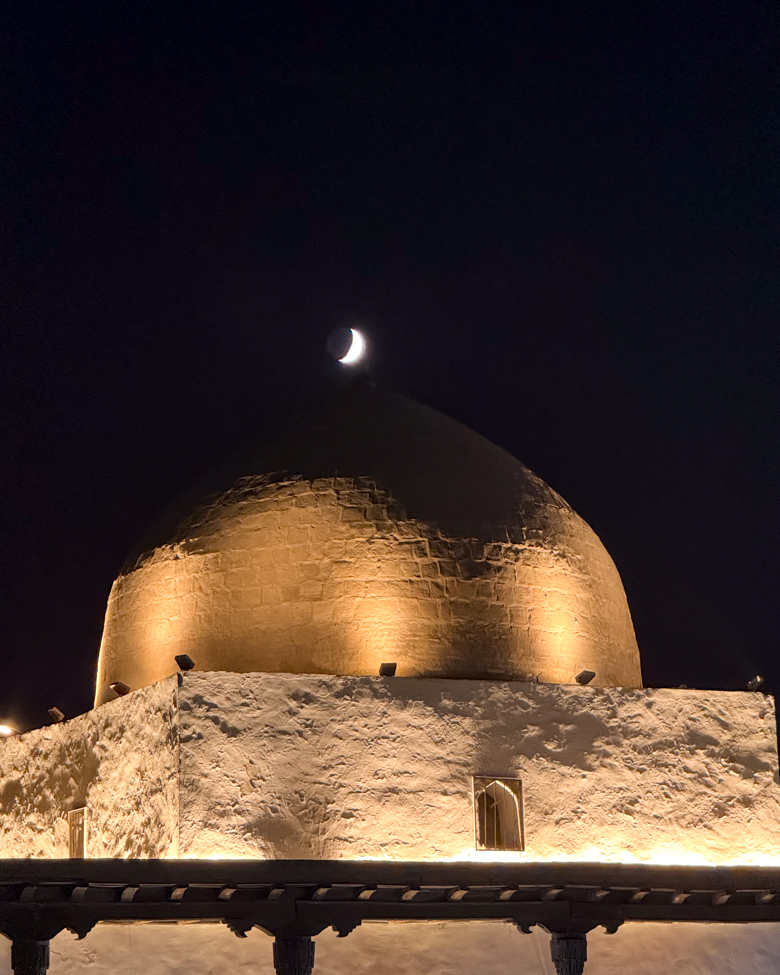
Where can I stay in Khiva?
There are lots of hotels and B&Bs both inside and outside the Itchan Qala. The price of accommodation outside the walls of the old town is less compared to the ones inside. The B&Bs inside Itchan Qala are costly, even more expensive than in Samarkand and Bukhara. However, we suggest staying inside the old town as it will give you the freedom to explore the attractions.
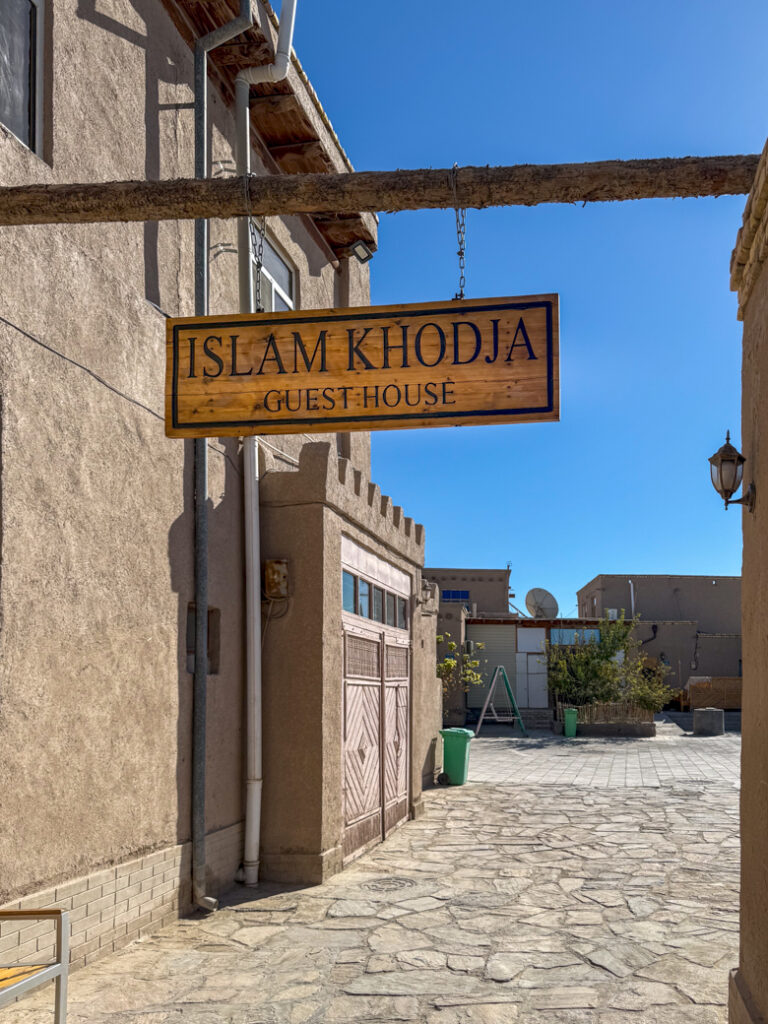
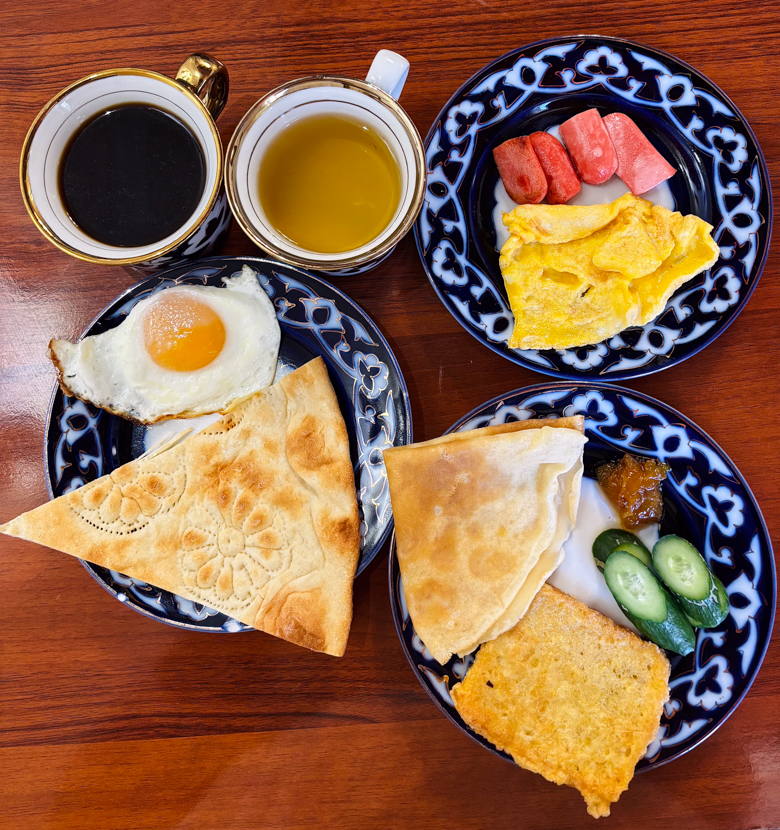
- Islam Khodja Guest House – This little B&B is located just behind the Islam Khodja minaret. The view of the minaret can be relished from its rustic courtyard. It was even visible from the window of our room. The room was however quite small despite the high price. The complimentary homemade breakfast was fantastic. For two nights, the price was USD 100. We booked a room from Booking.com.
- Hotel Orient Star (inside the Mohammad Amin Khan Madrassa).
- Madrassa Polvon Qori Boutique.
- Otabek B&B.
- Nazira Boutique Hotel & Terrace.
Where can I eat in Khiva?
Inside Itchan Qala, there are only a handful of quality restaurants. Given the thousands of tourists who visit Khiva, getting a table in the eateries is a real challenge (especially during the weekends). So, go to your preferred restaurants early to grab a seat, or reserve a table beforehand. Moreover, restaurants are expensive in Khiva when compared to Samarkand and Bukhara.
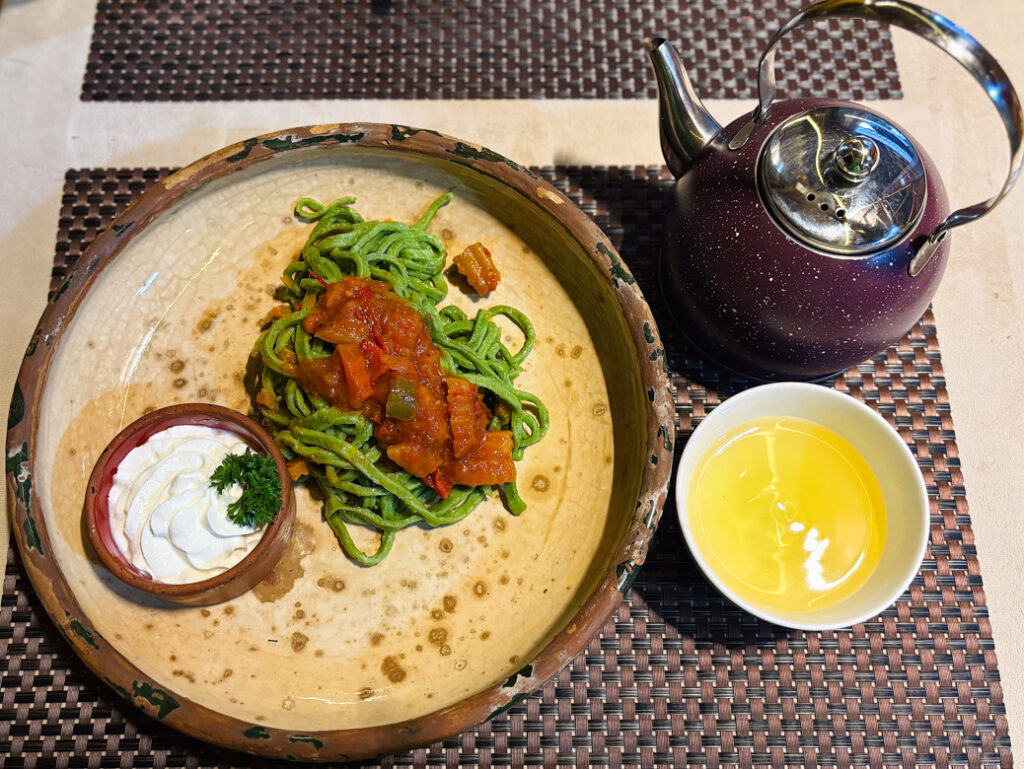
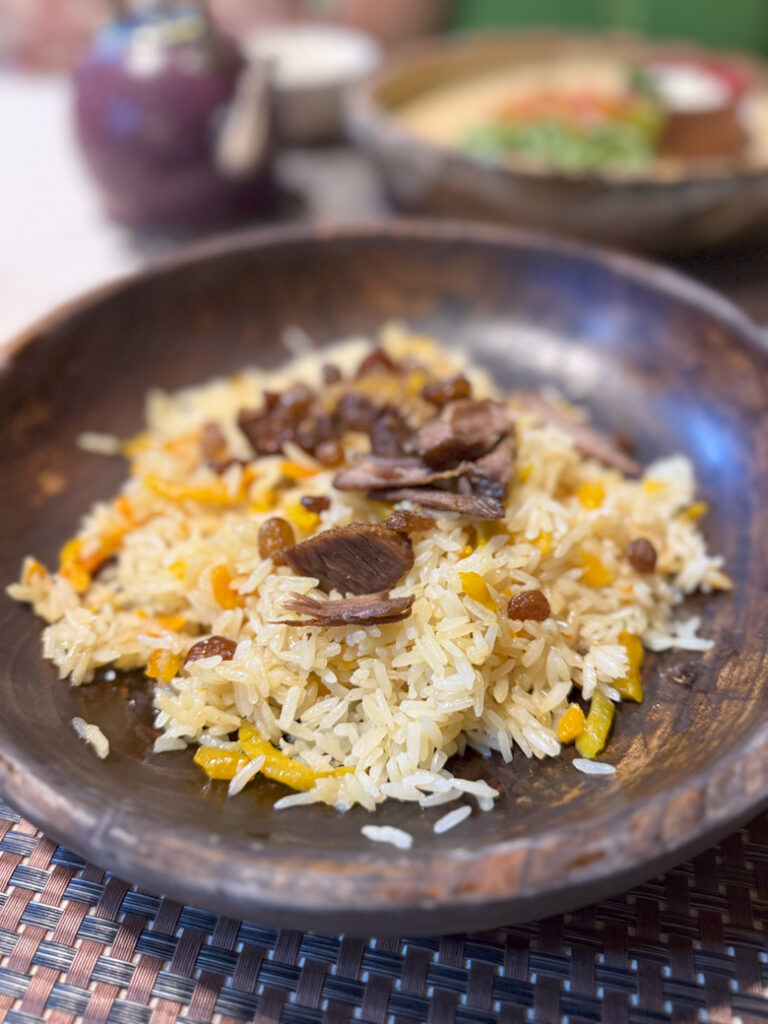
- Terrassa Café – Popular rooftop restaurant known for great sunset views.
- Bir Gumbaz Chai Khana – Homemade Uzbek delicacies with a fantastic view of Kalta Minor.
- Khorezm Art Restaurant – Located inside an old madrassa with a menu of Khorezm delicacies.
- Café Zerafshon – Popular joint near Islam Khodja Minaret with terrible service and average food.
- Malika Kheivak – Nice selection of vegetarian foods.
- Khiva Moon – A charming restaurant outside the Itchan Qala.
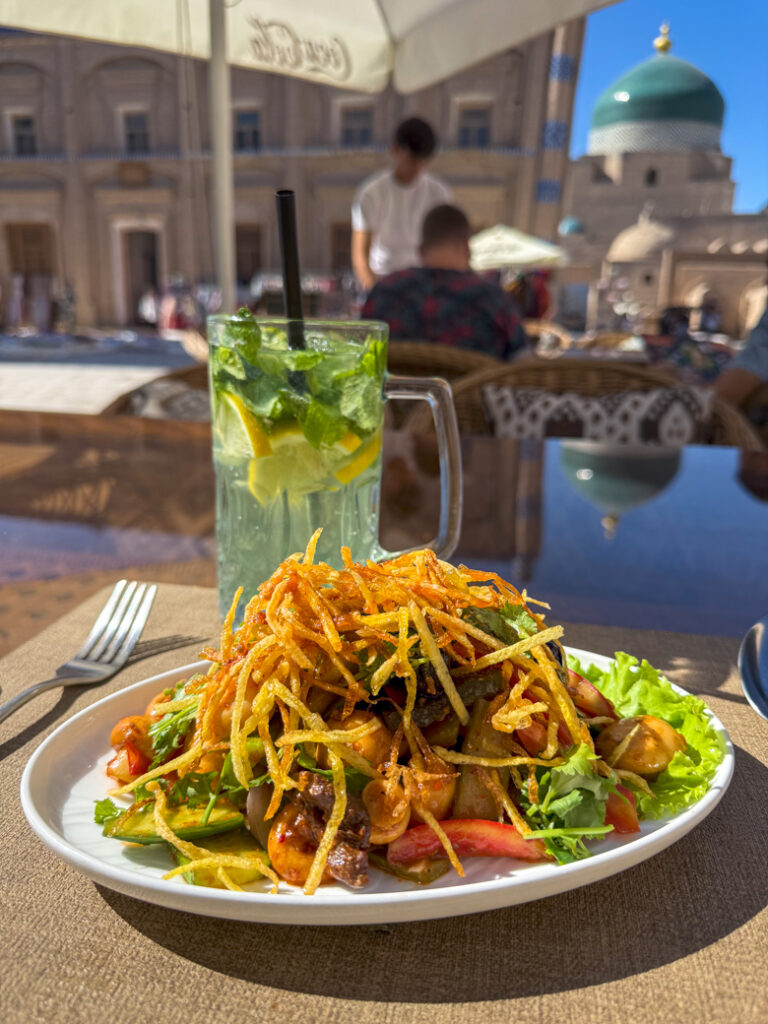
What to eat in Khiva?
In Khiva, you will find a handful of Khorezm delicacies, not found elsewhere in Uzbekistan. Make sure to try them out. There is Shivit Oshi (green dill pasta served with sour cream), Gumma (pie with meat filling), Tuxum Barak (egg dumplings with yoghurt), Qiyma Zarafshon (egg crepes with meat filling) and pumpkin dumplings.
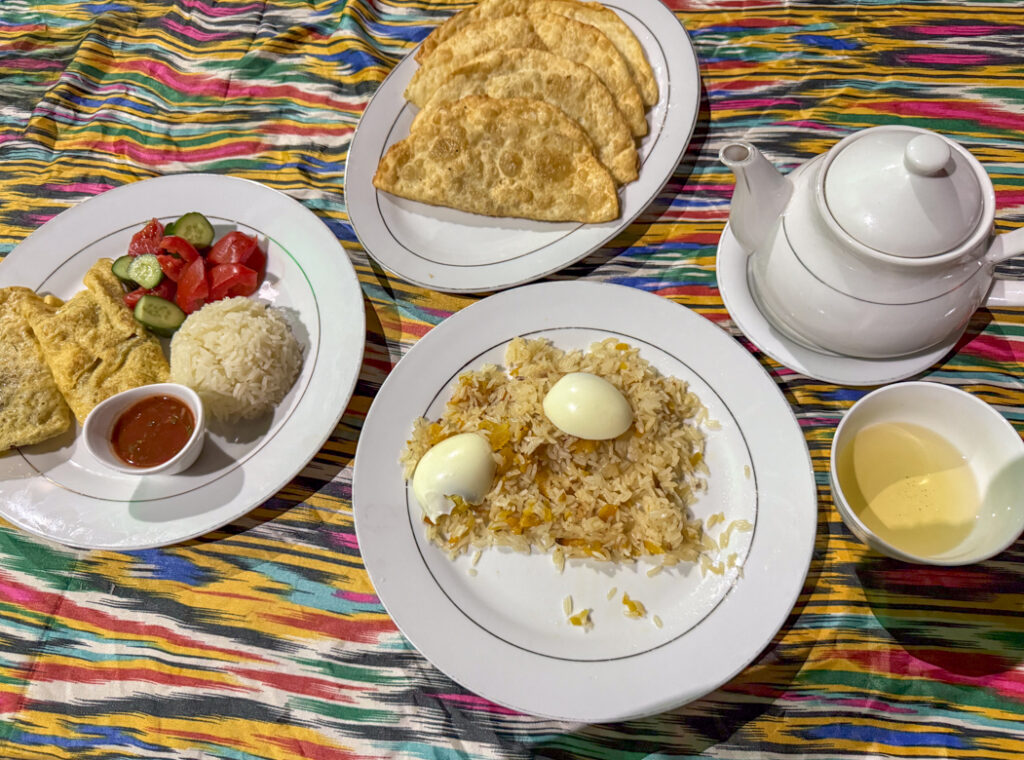
Can I get vegetarian food in Khiva?
Compared to Samarkand and Bukhara, finding vegetarian food is easier in Khiva. In every restaurant, you can relish pumpkin-filled dumplings, spinach dumplings, Gumma with potato stuffing, and Shivit Oshi with a sauce made of pumpkin, yellow carrots, and tomato.
How to get around Khiva?
Khiva can be easily explored on foot, provided you are staying inside Itchan Qala. All the attractions are located within a small radius.
Please note that Yandex cabs are not available in Khiva.
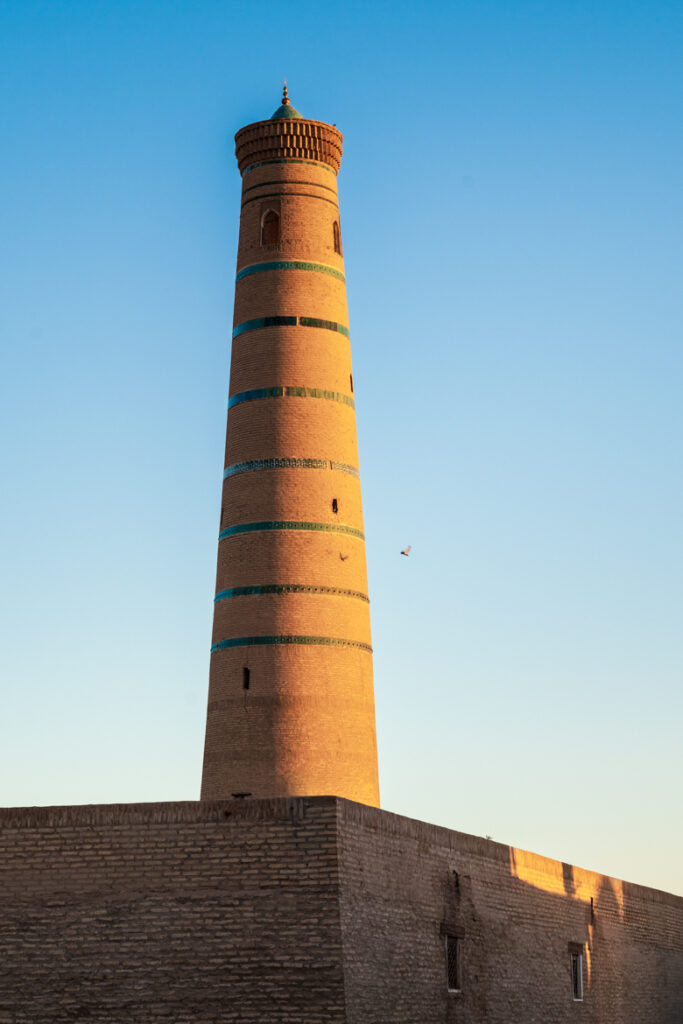
What to pack for Khiva?
There is no strict dress code in Khiva. However, most of the attractions are religious. Hence, pack modest dresses that cover your arms and legs. Avoid shorts, miniskirts, off-shoulder dresses, or any mid-riff baring clothes.
Exploring Khiva involves lots of walking. Pack comfortable shoes and sandals.
Don’t forget your sunscreen, moisturiser, wide-brimmed hats, sunglasses, and umbrellas.
If you are visiting in October, pack light woollens as dawns and evenings get a bit chilly.
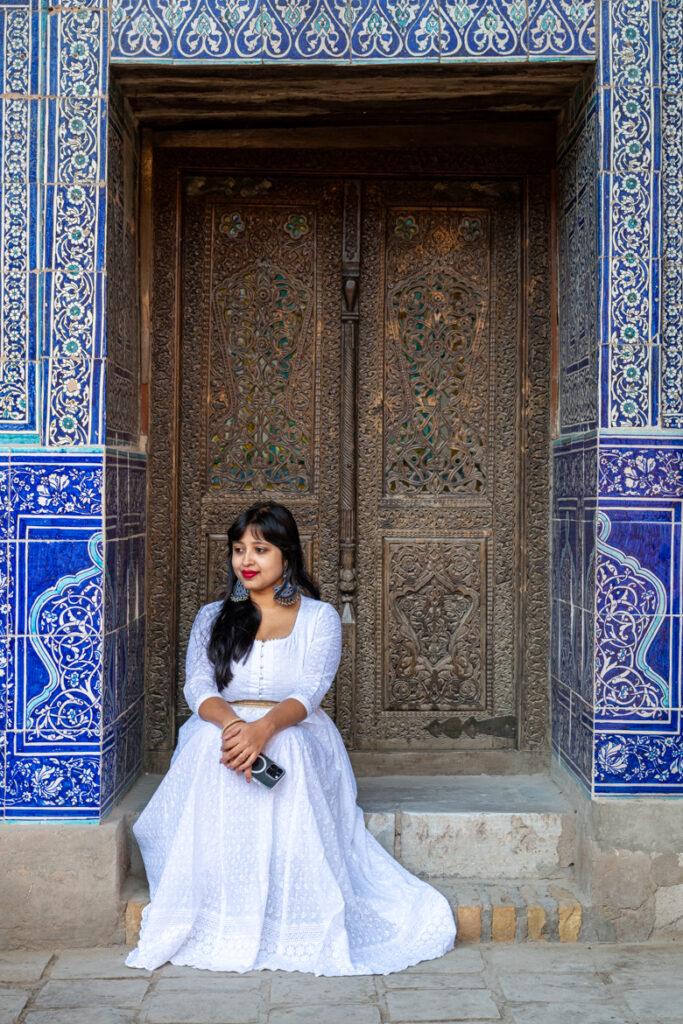
Where to shop in Khiva?
All the lanes and by-lanes in Khiva are lined with shops selling myriad souvenirs – from embroidered woollens to Chugurma or fur hats, from junk jewellery to fridge magnets, from Uzbek dolls to miniature blue tiles. However, the prices are steep and you need to bargain.
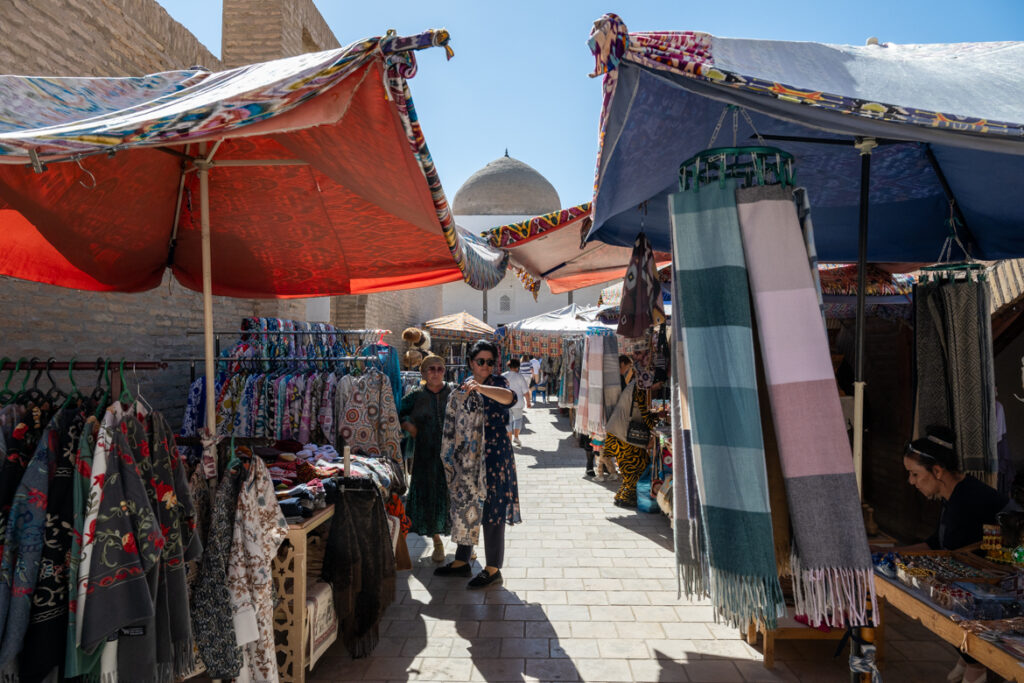
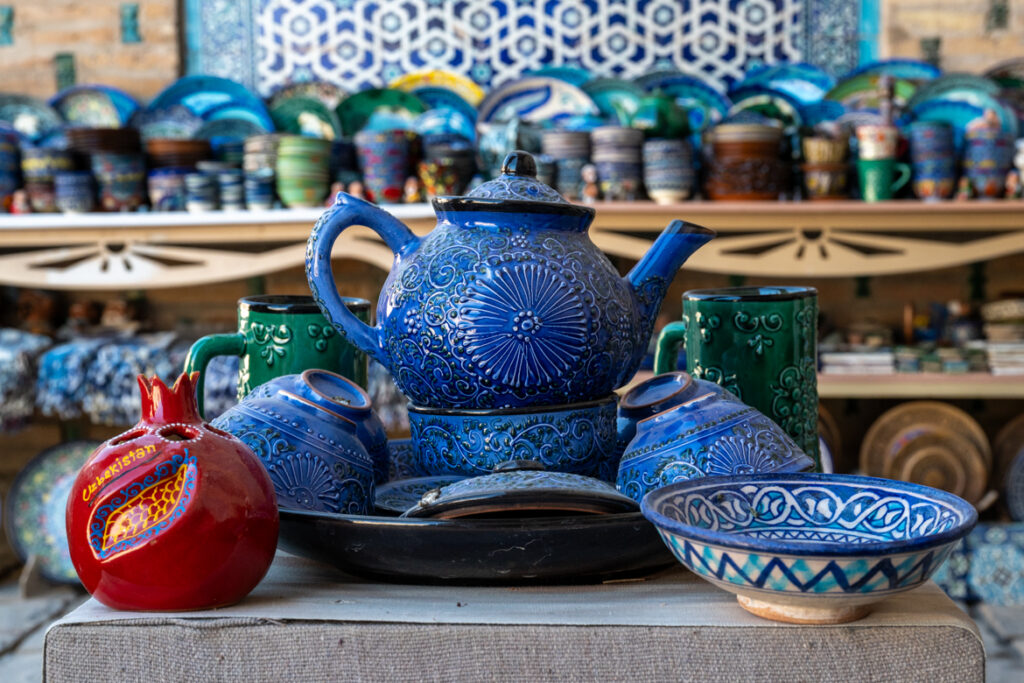
Travel agencies in Khiva:
Islambek Travel and Islam Khodja Travel are the reliable ones for organizing tours in Khiva and the area nearby.
Money exchange in Khiva:
You can exchange money easily from the bank located just across the Kalta Minor and beside the Bir Gumbaz Chai Khana.
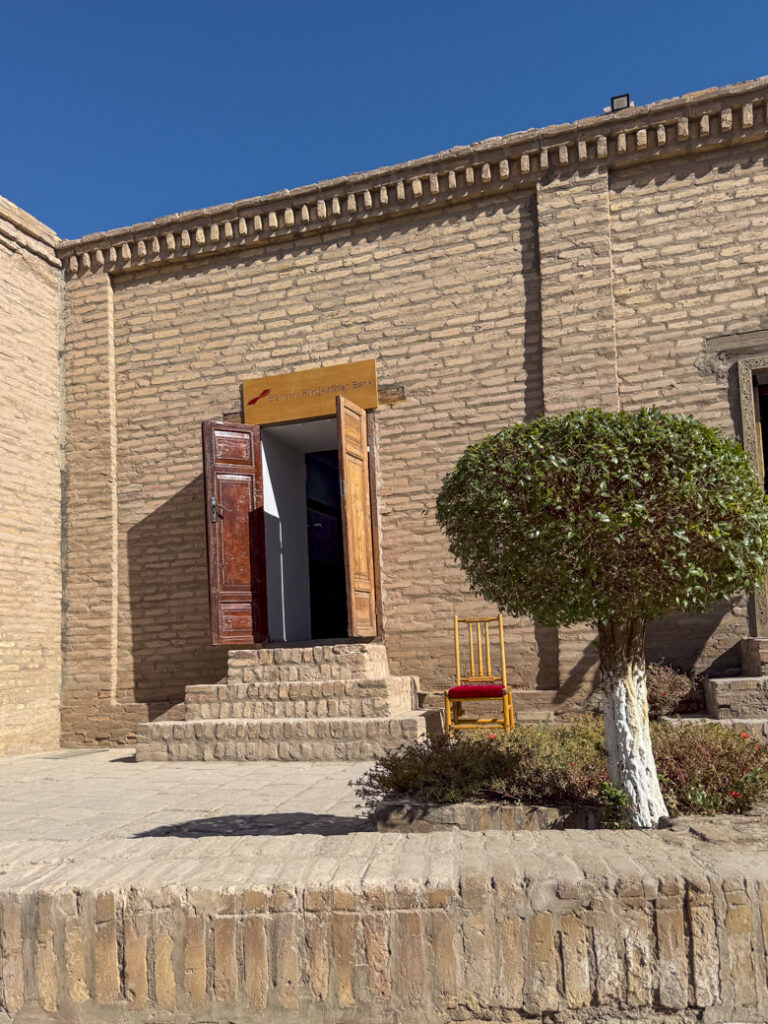
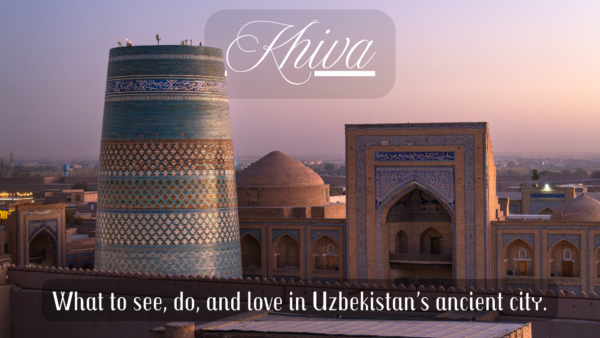
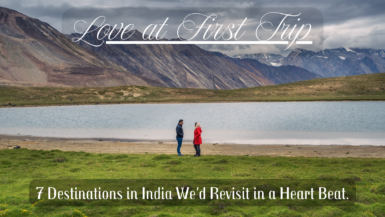
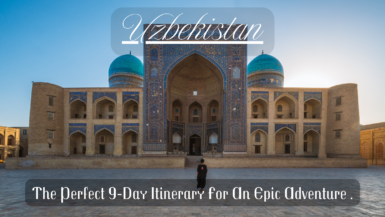
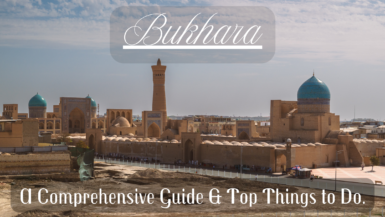
Leave a reply